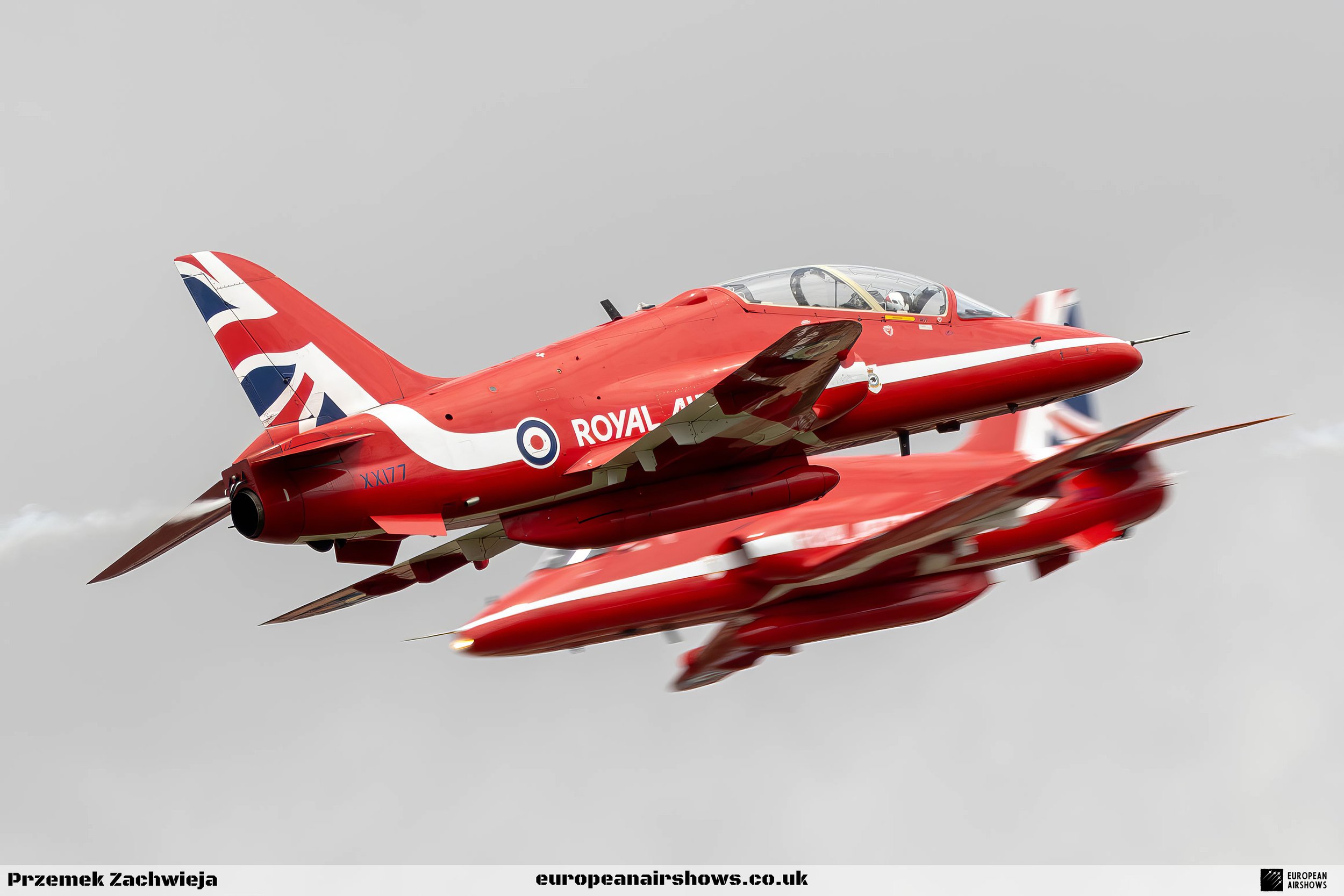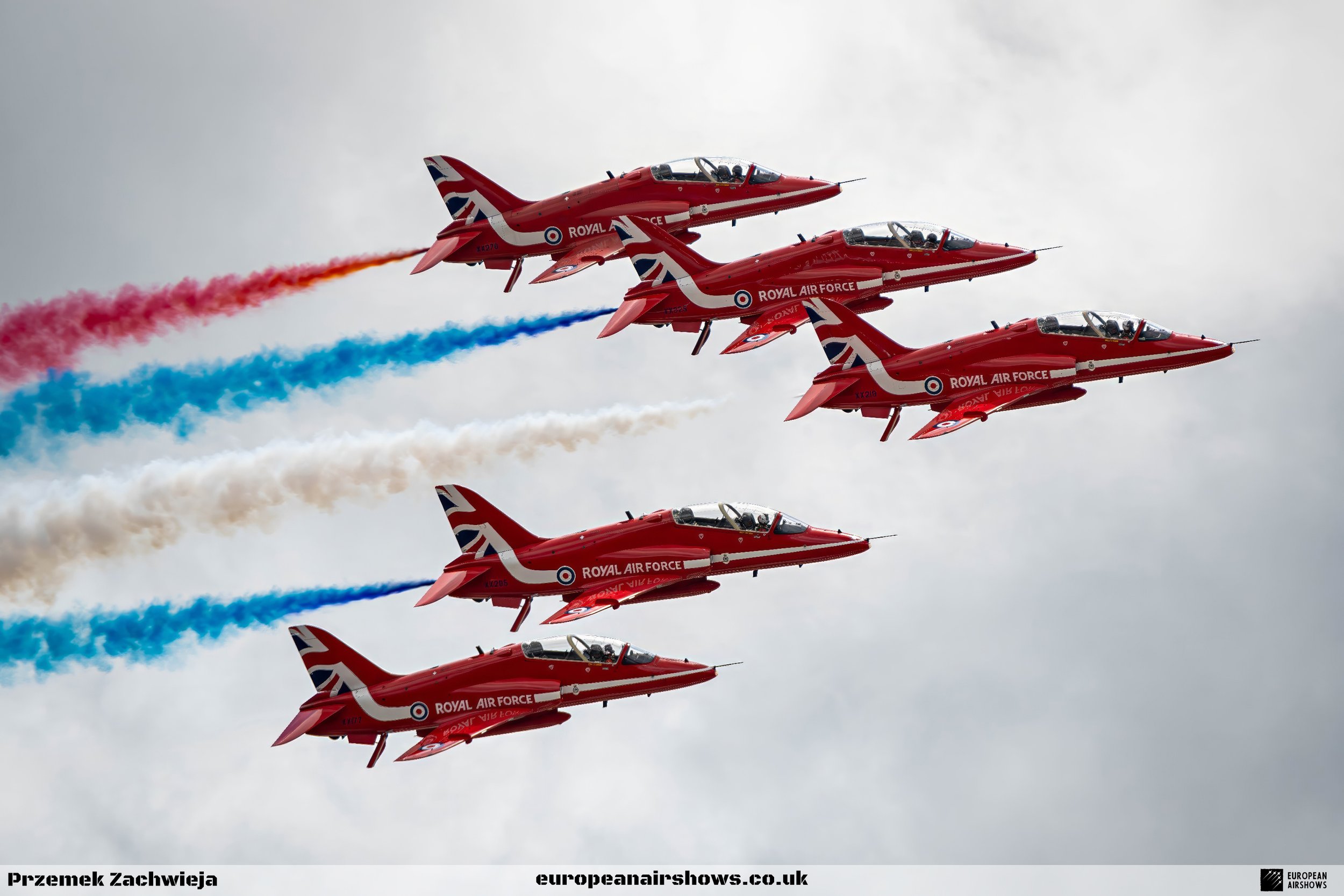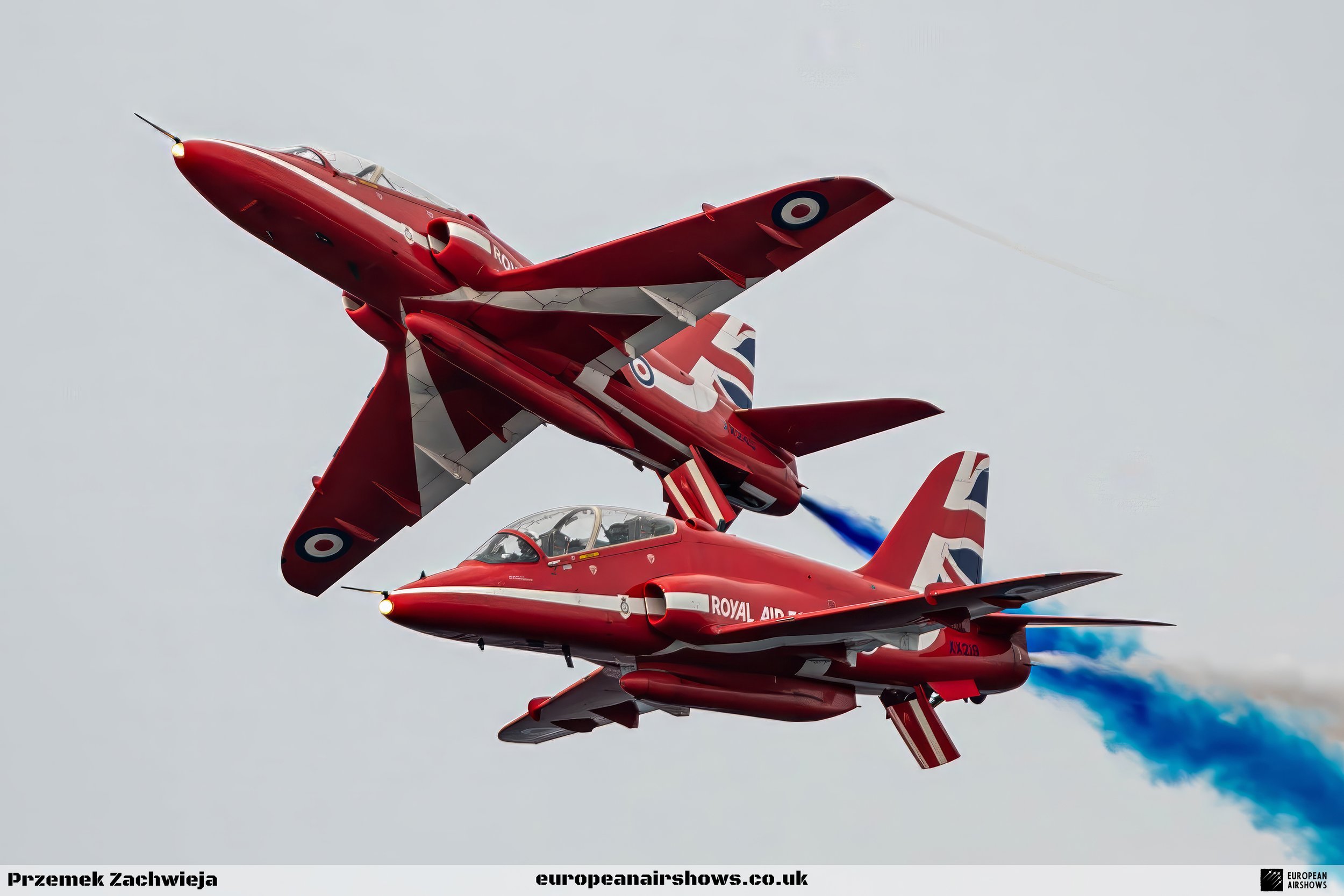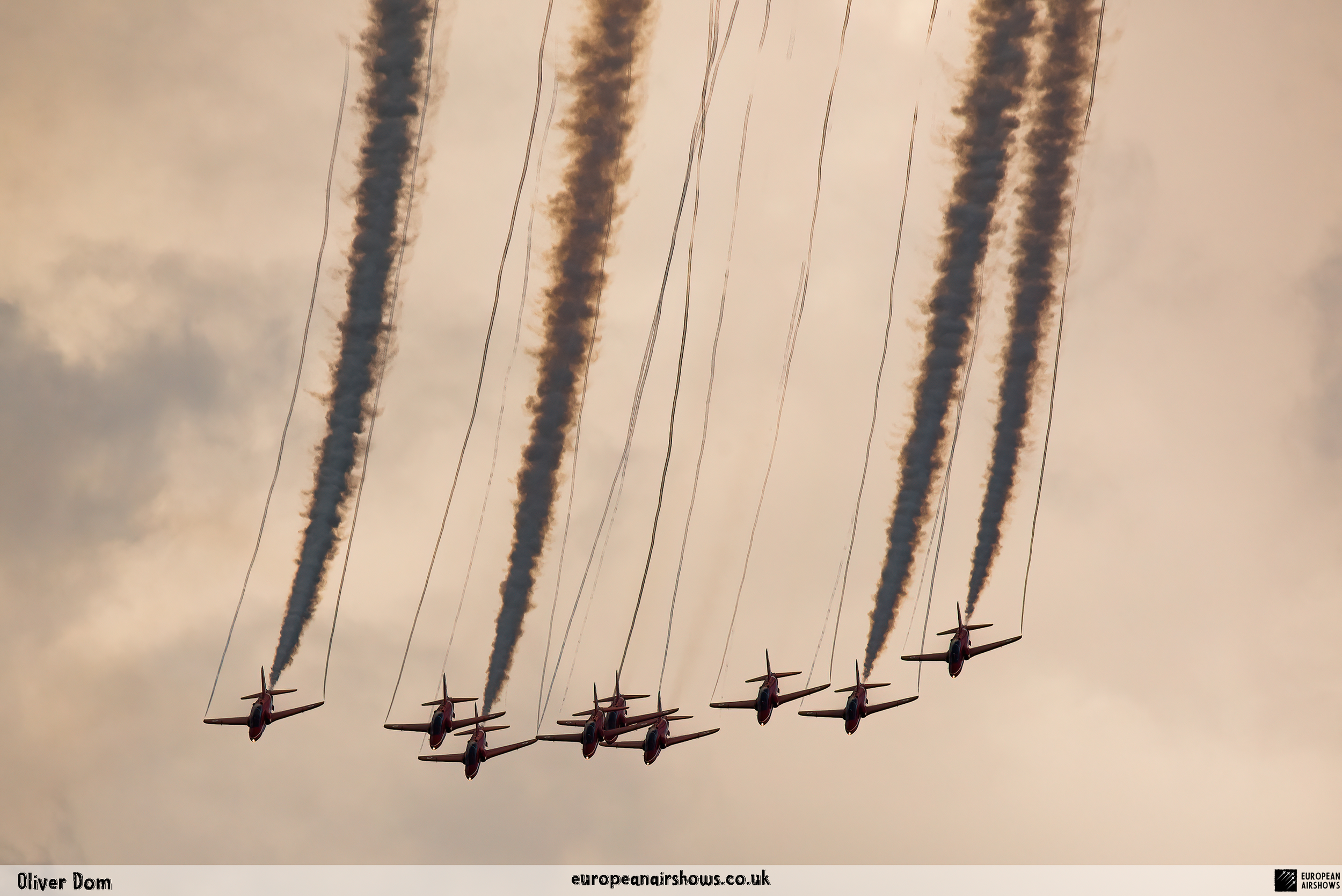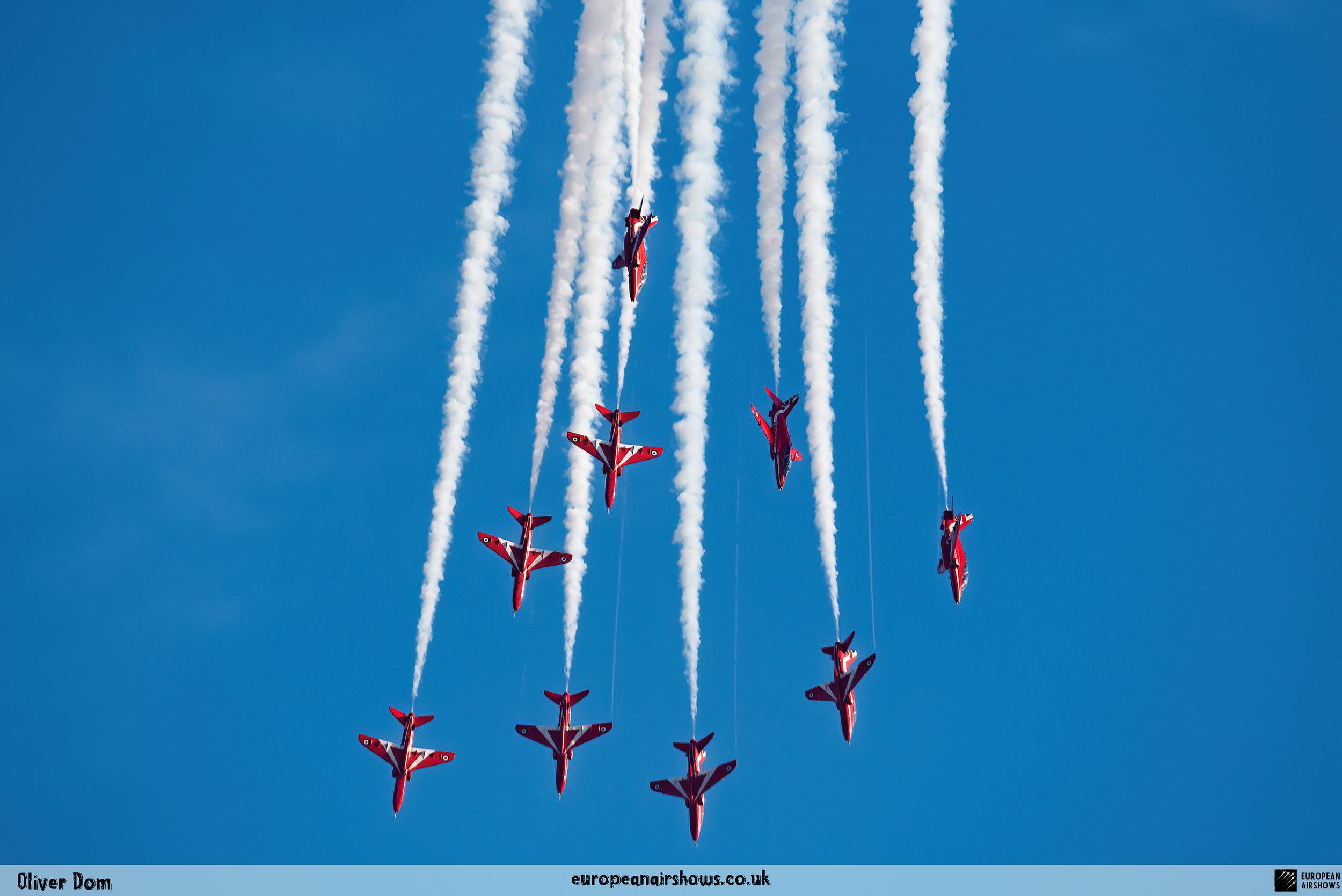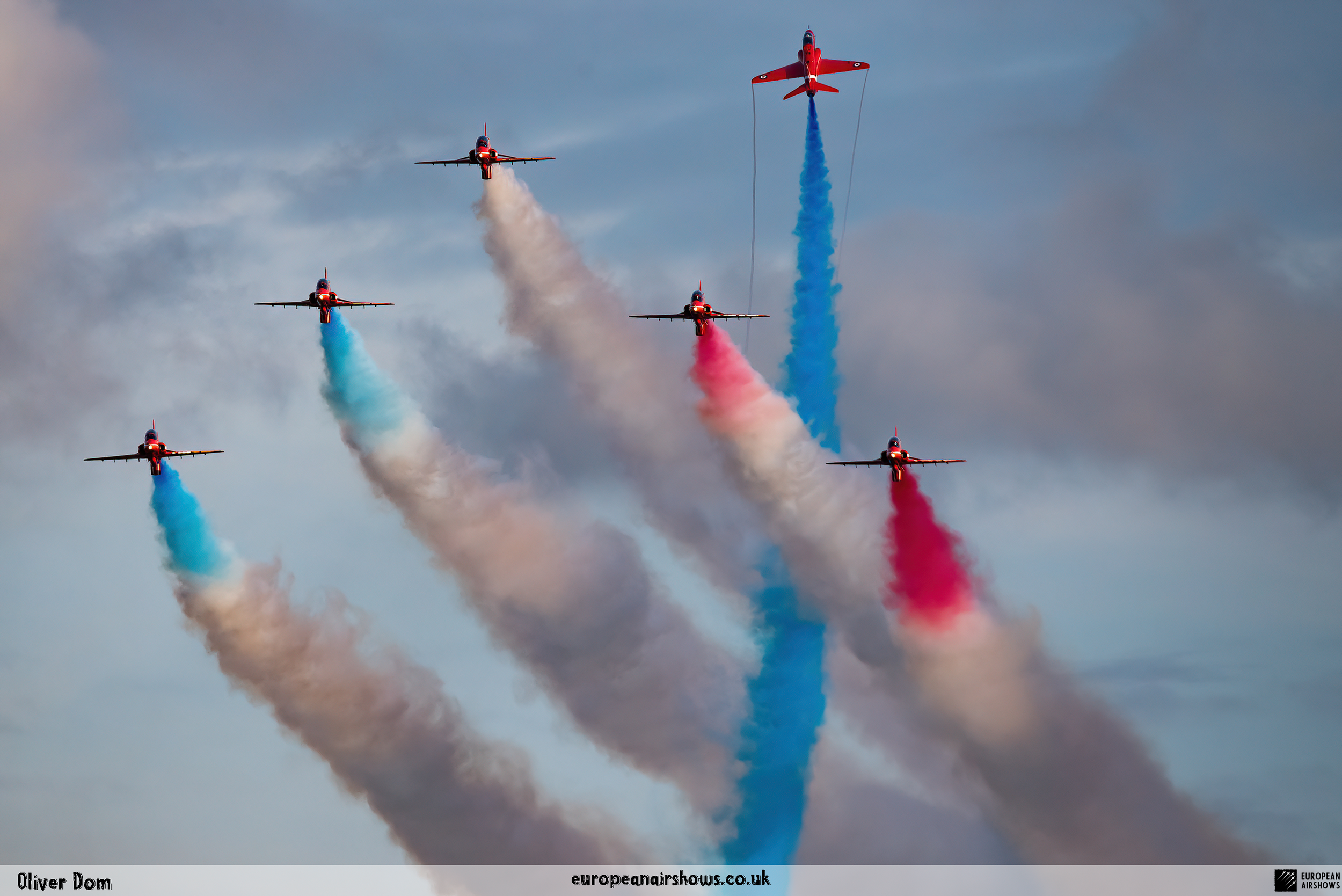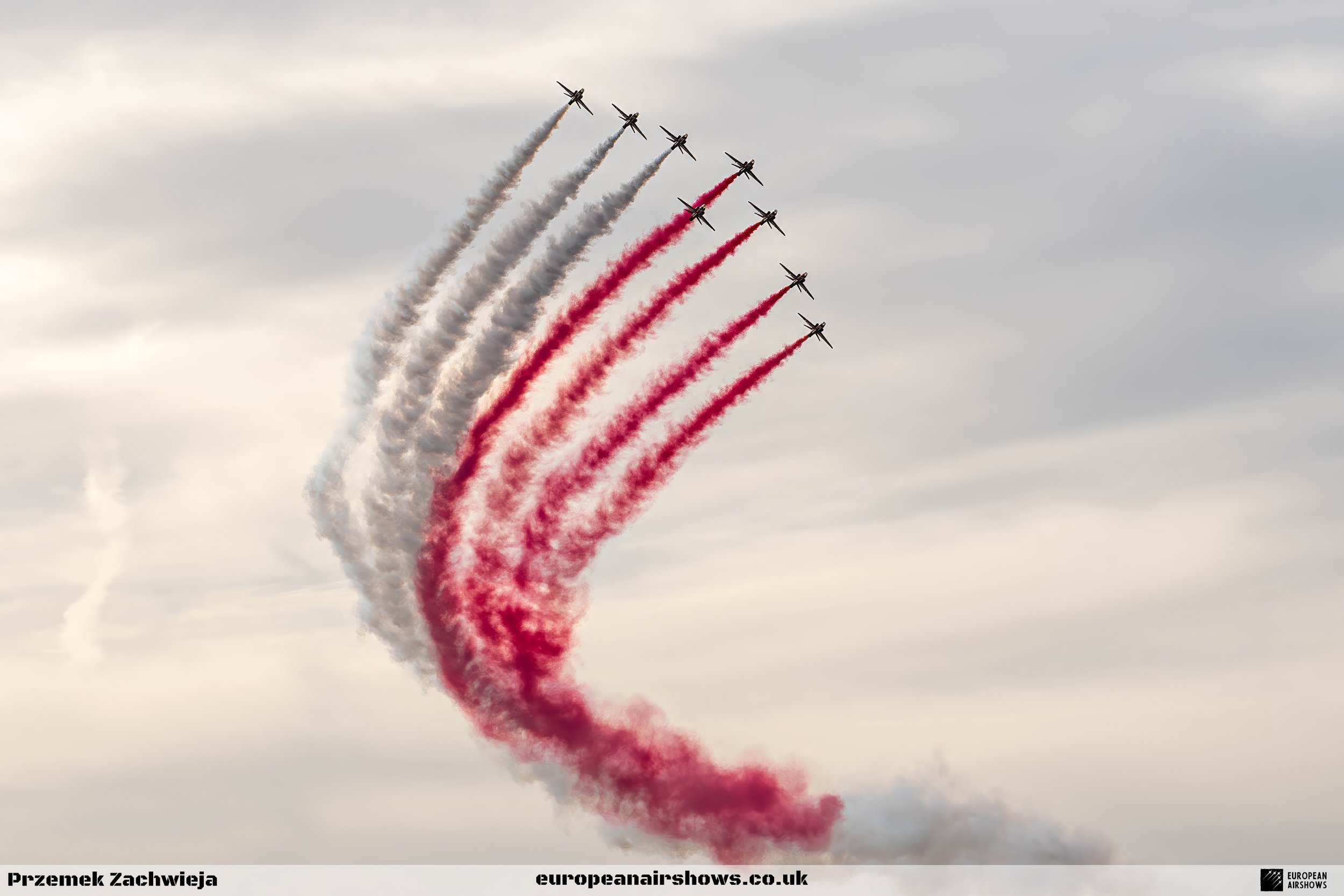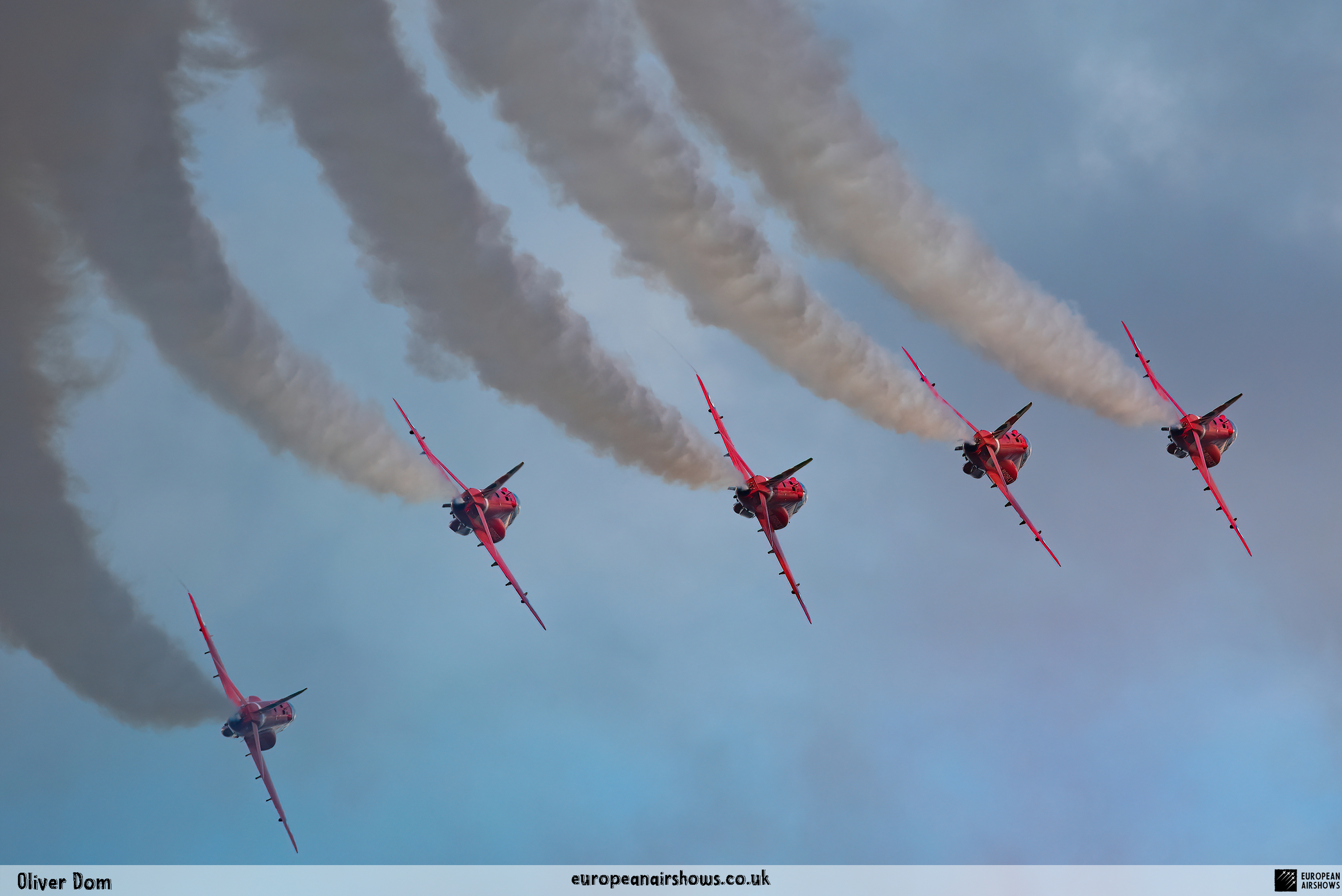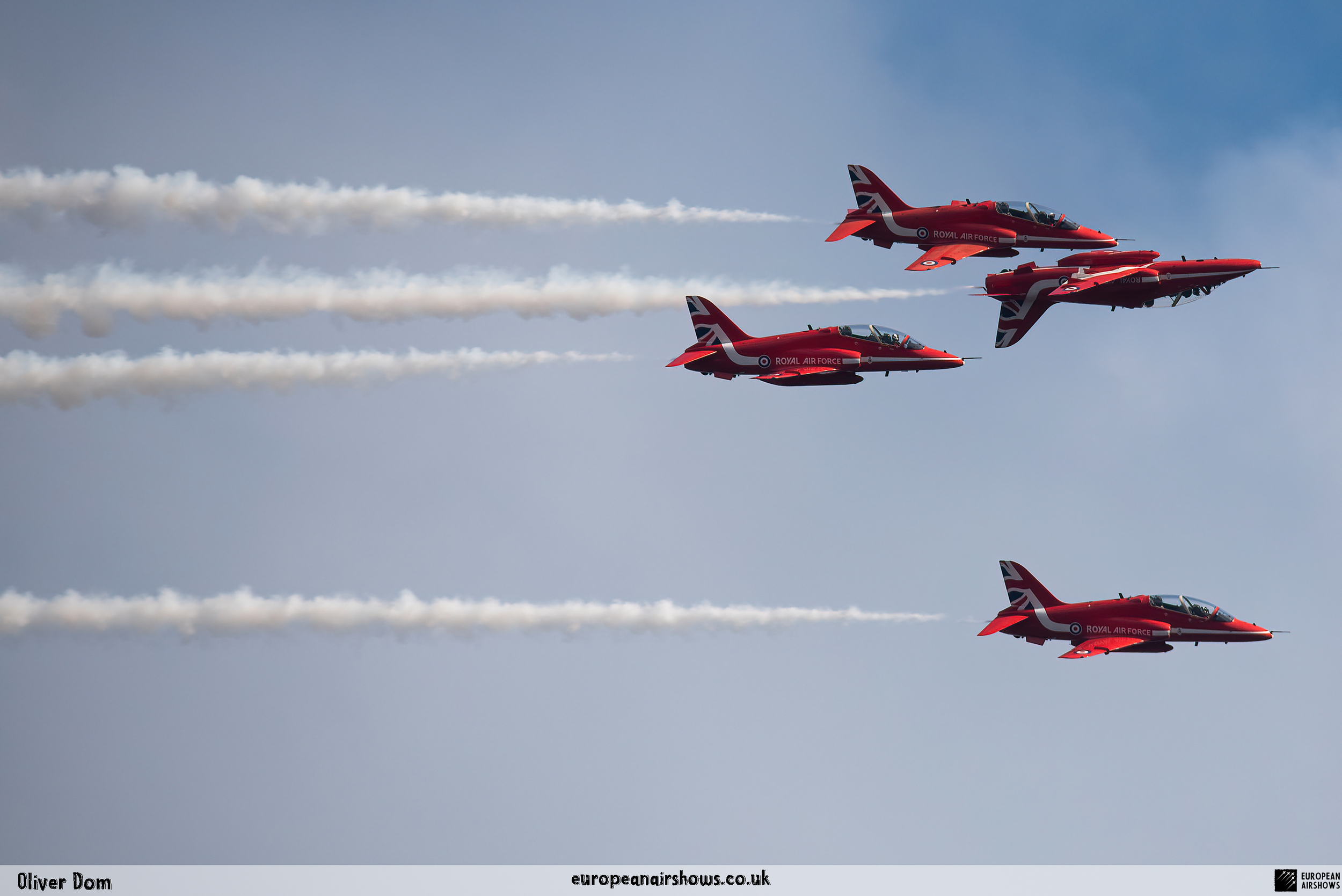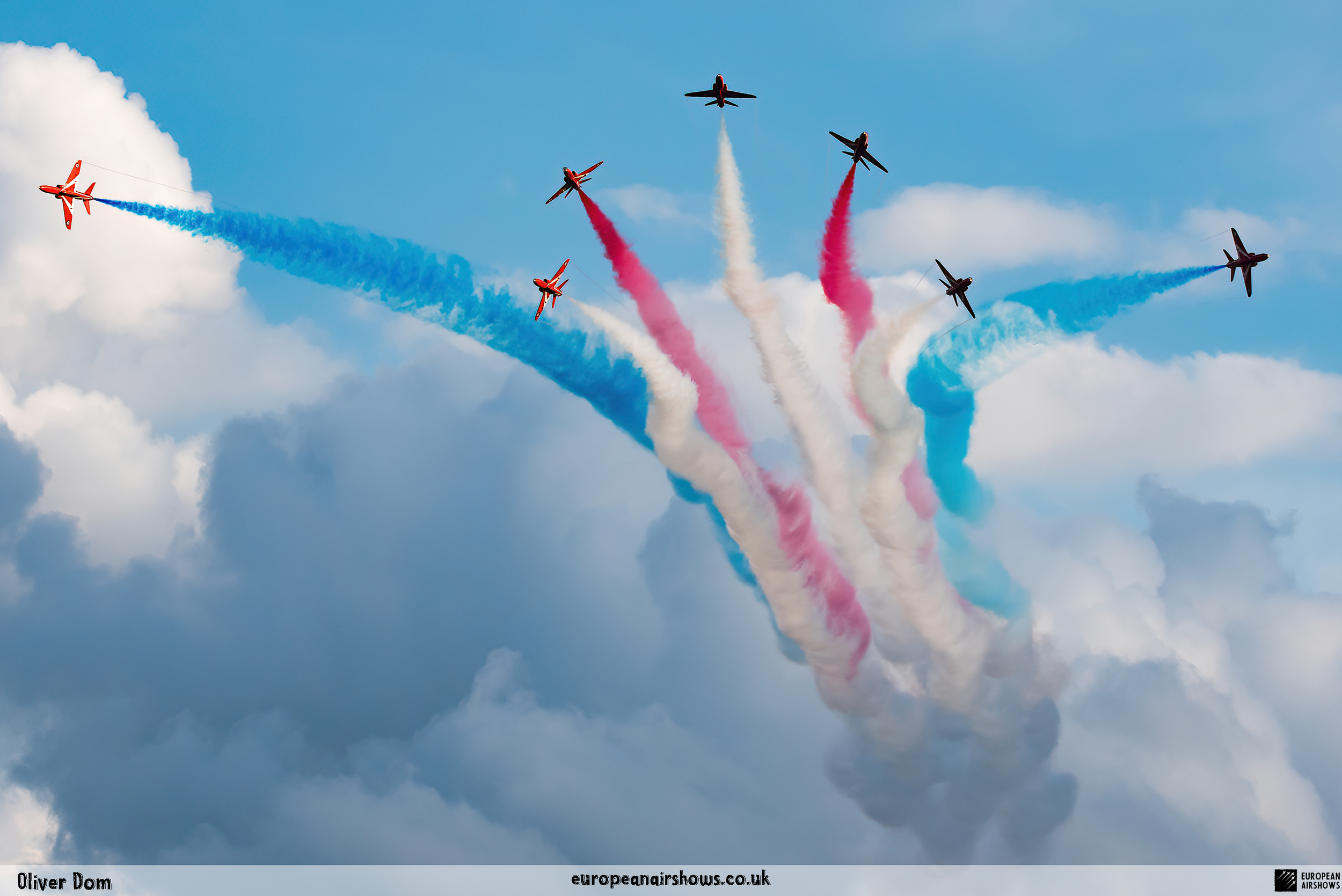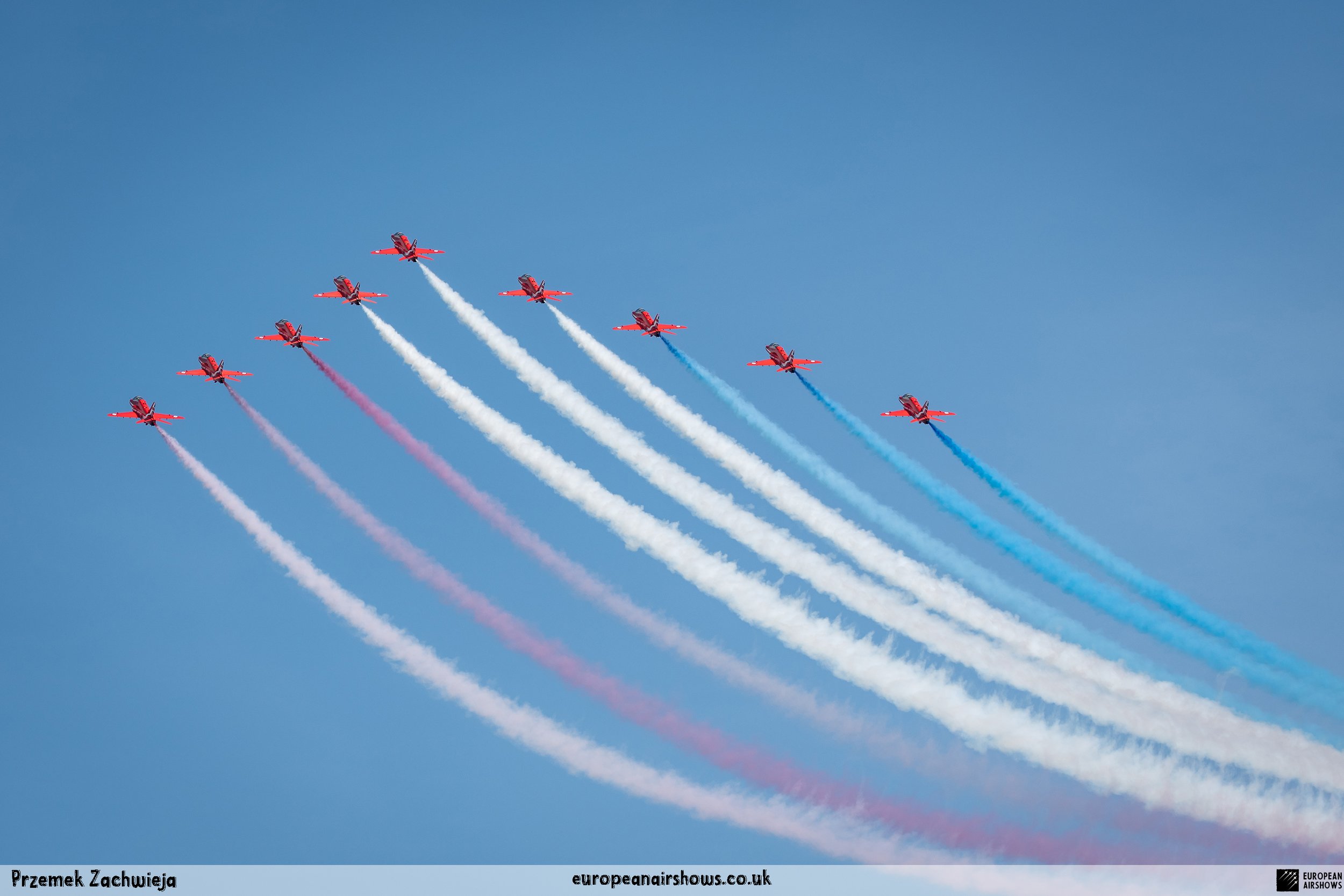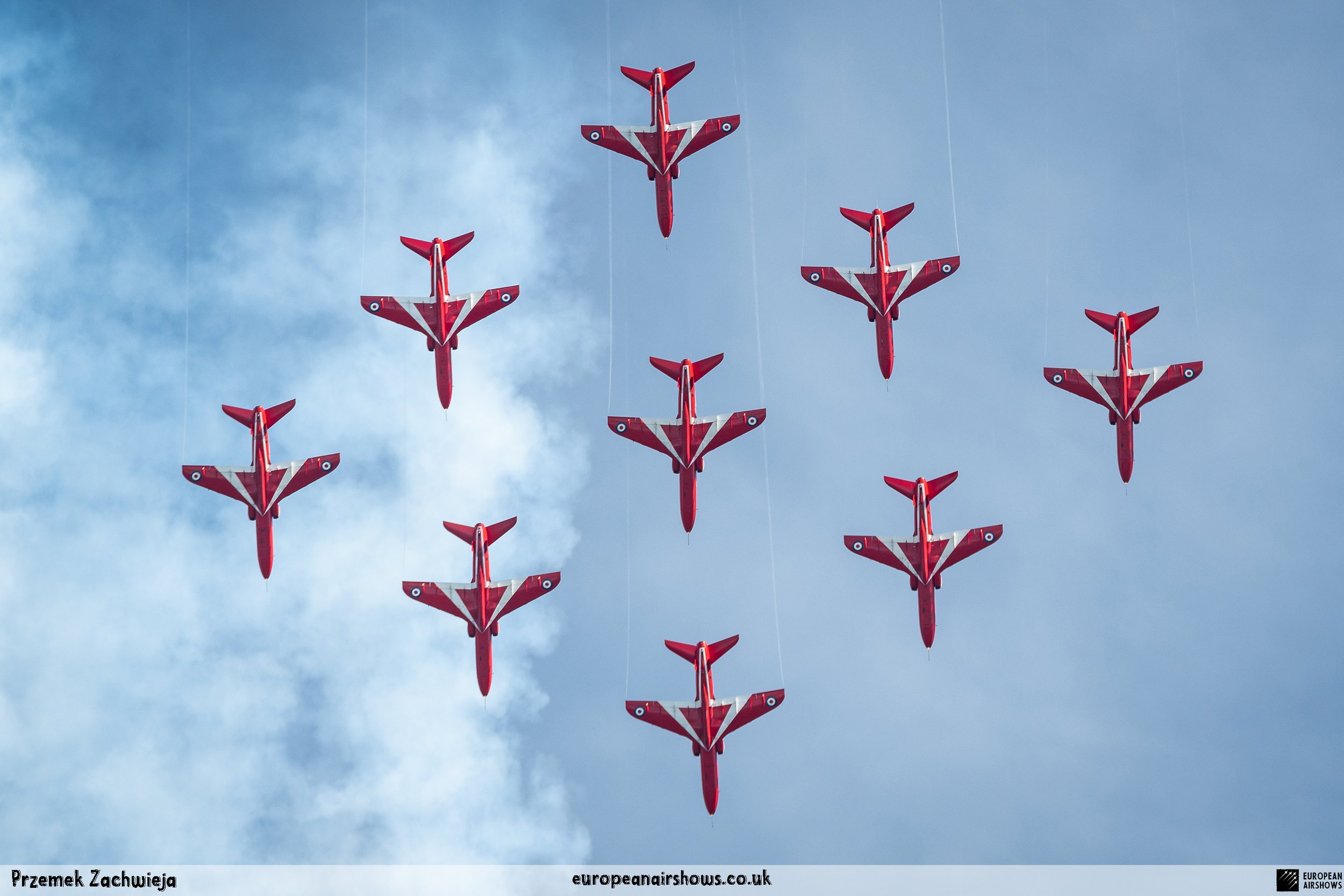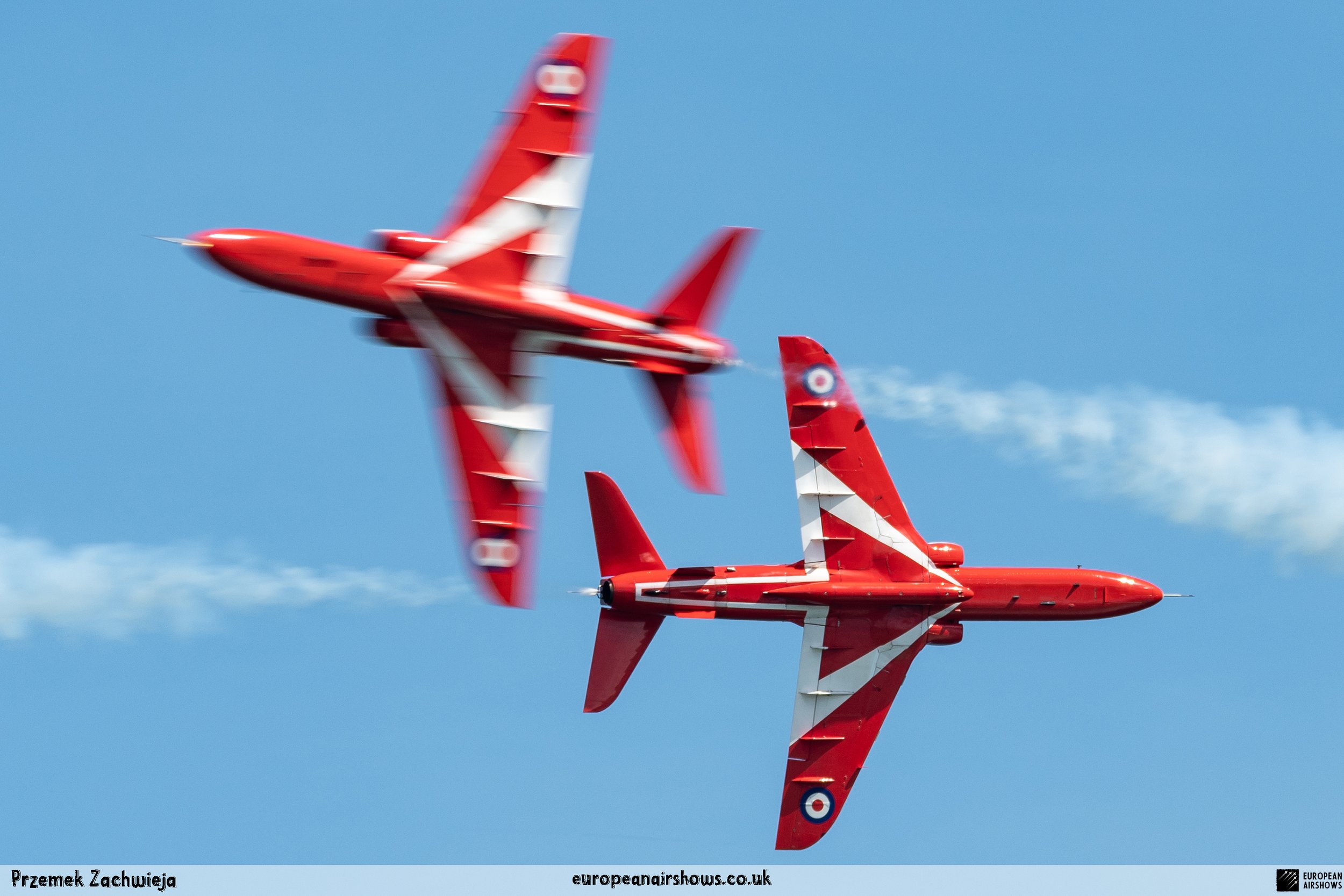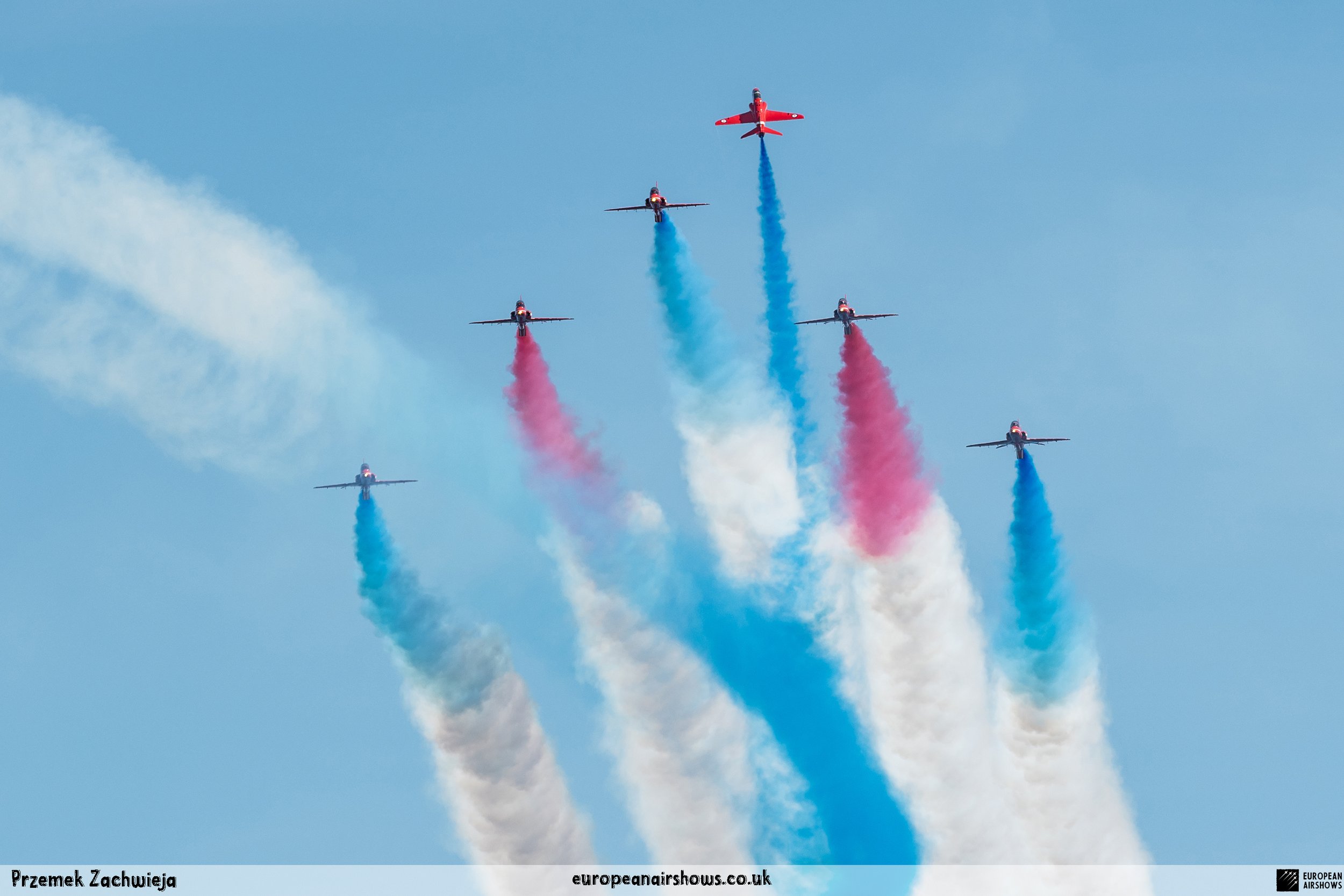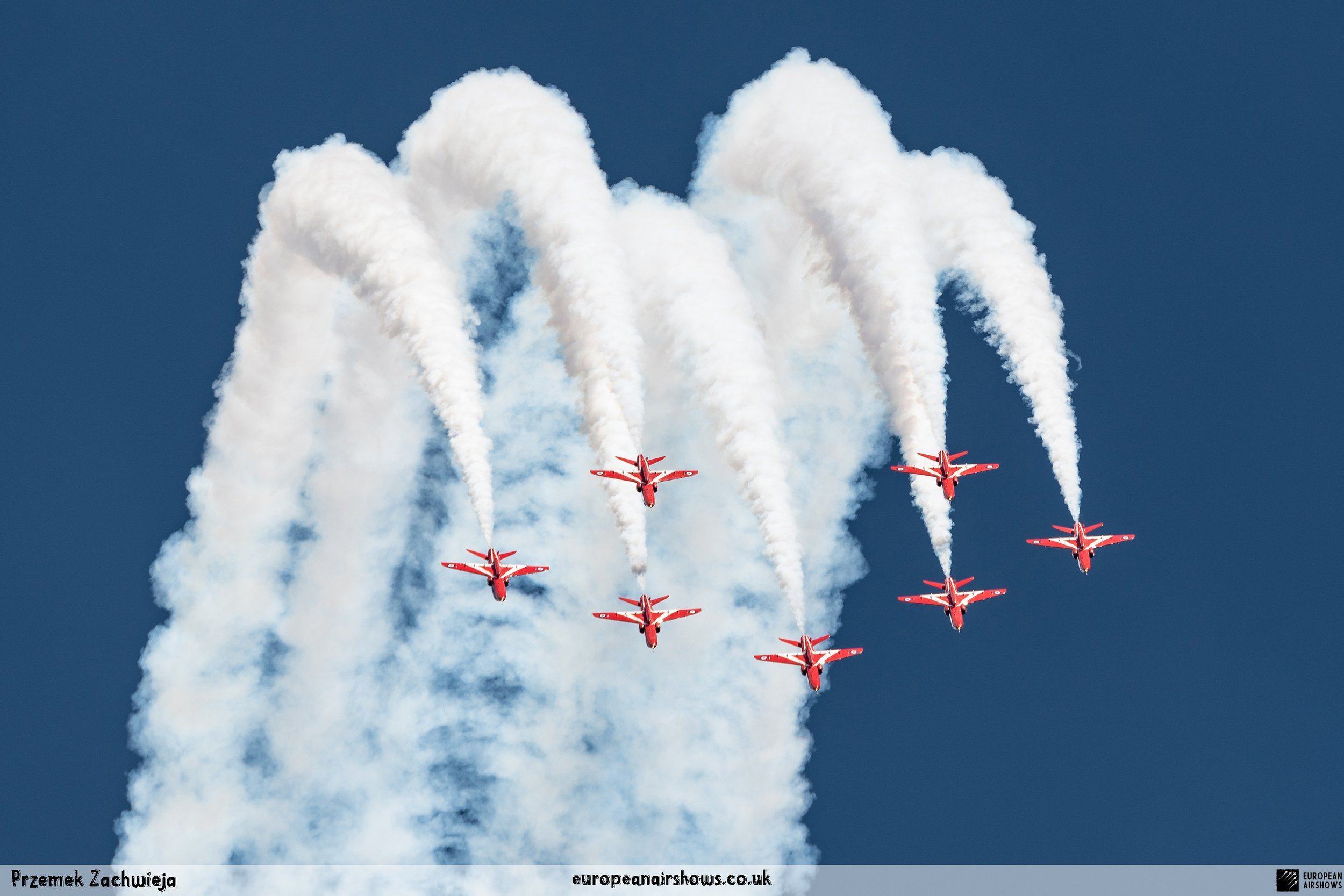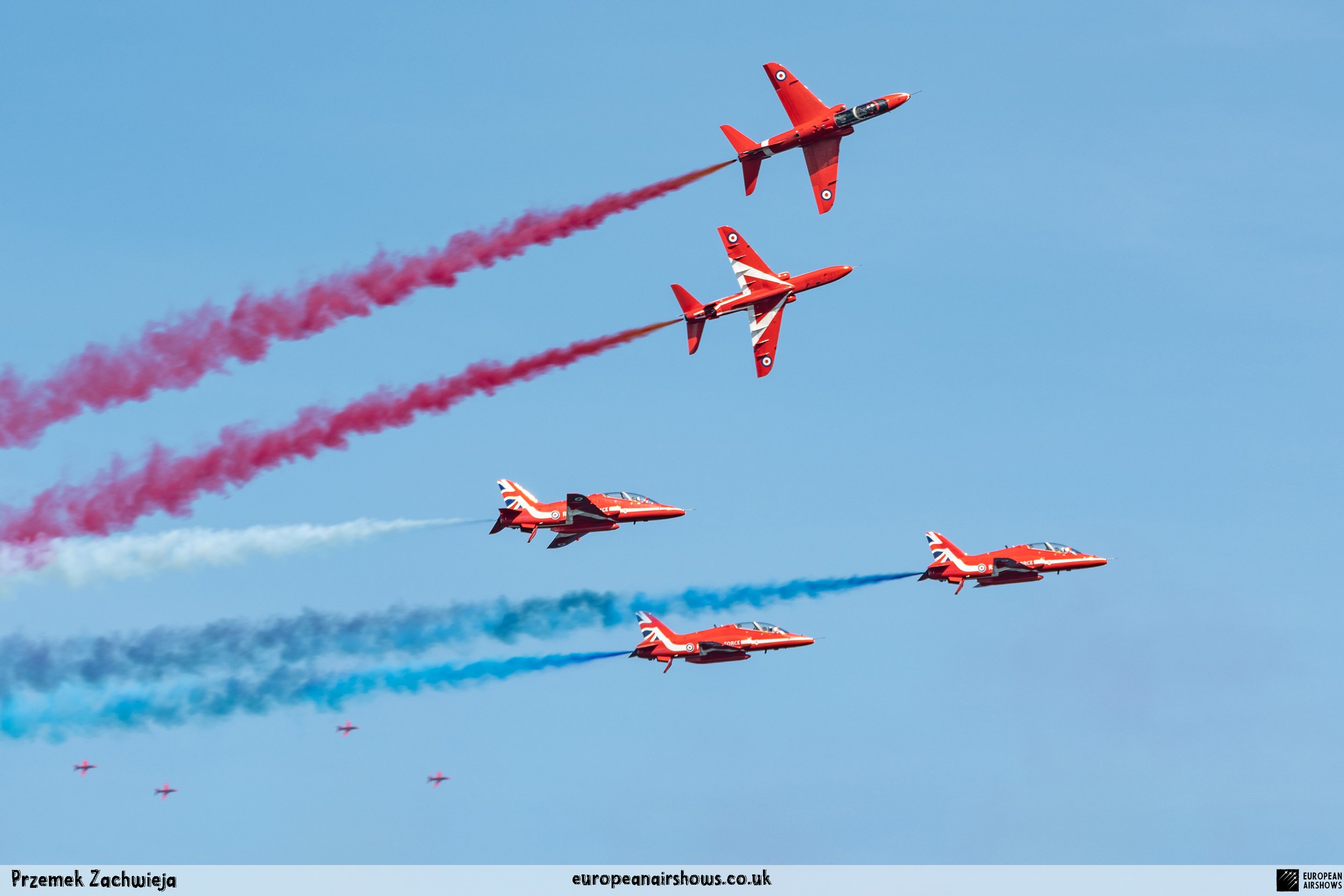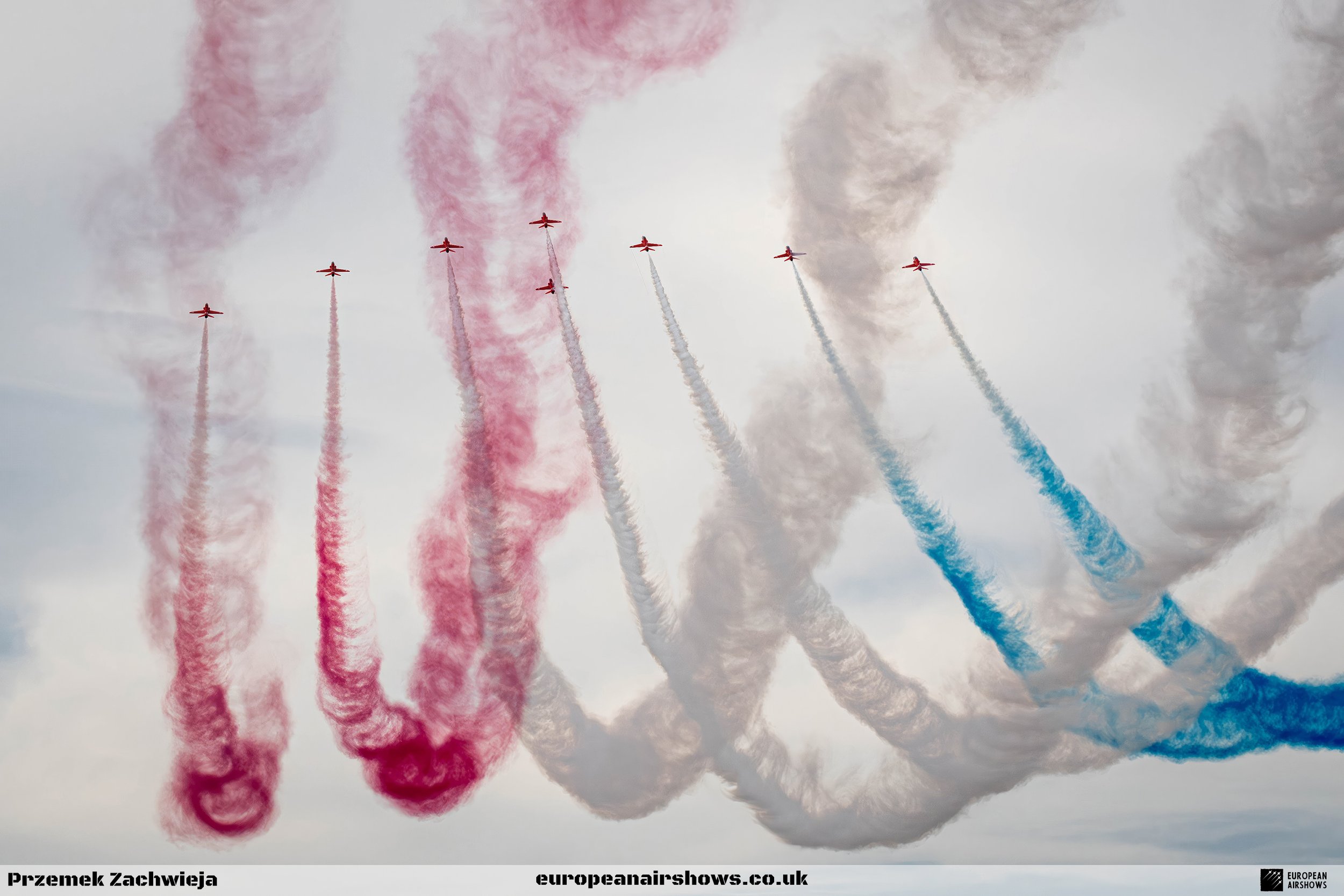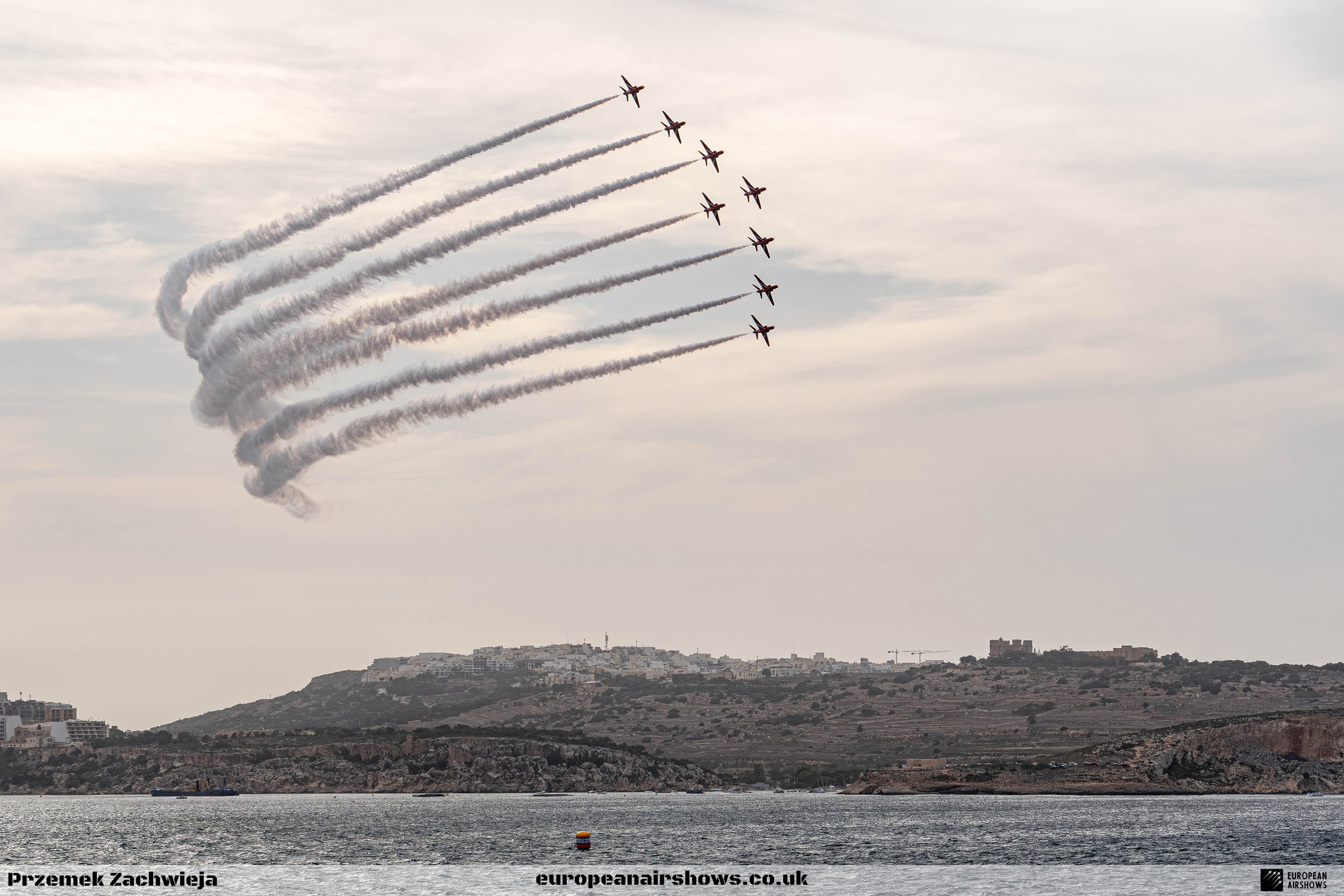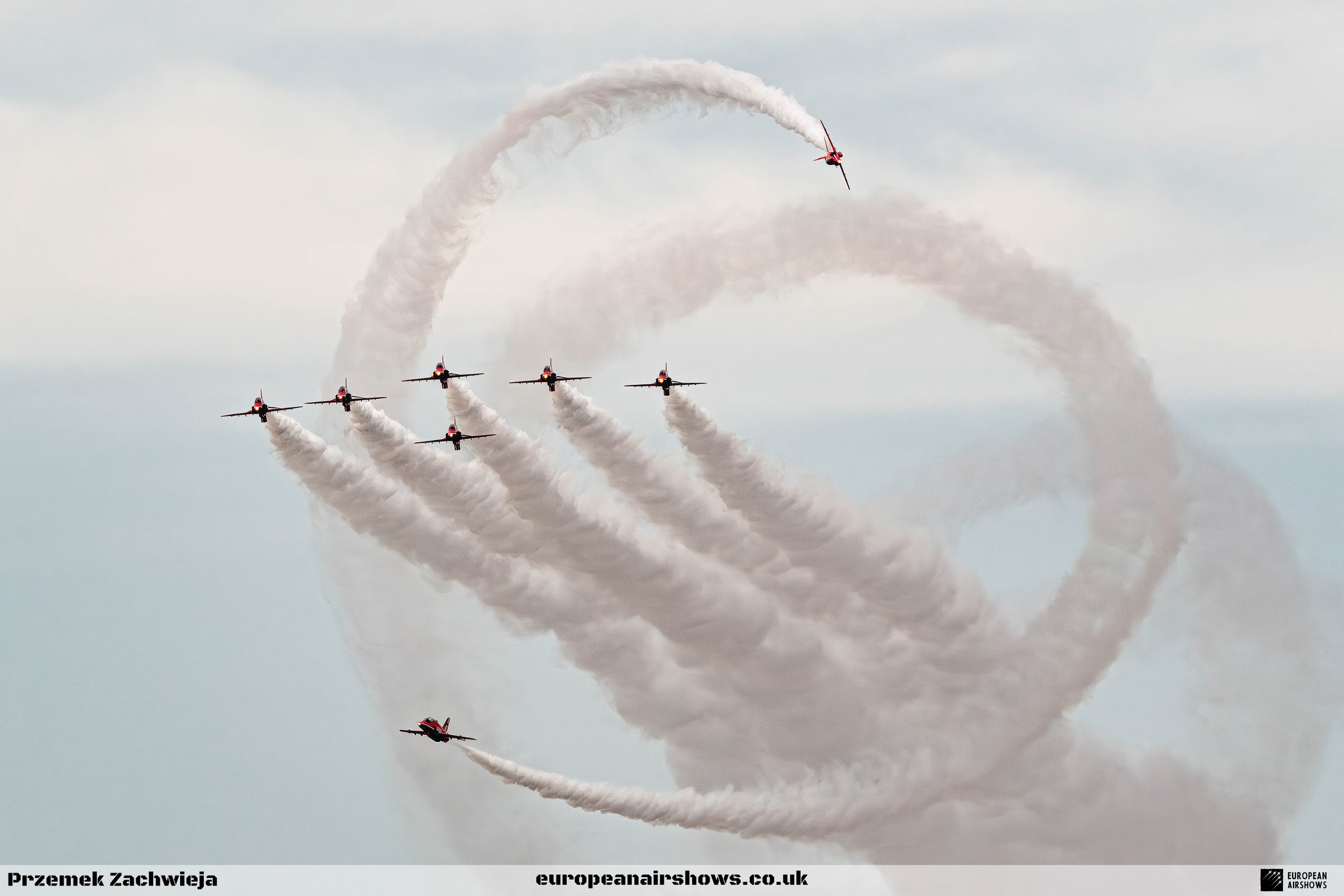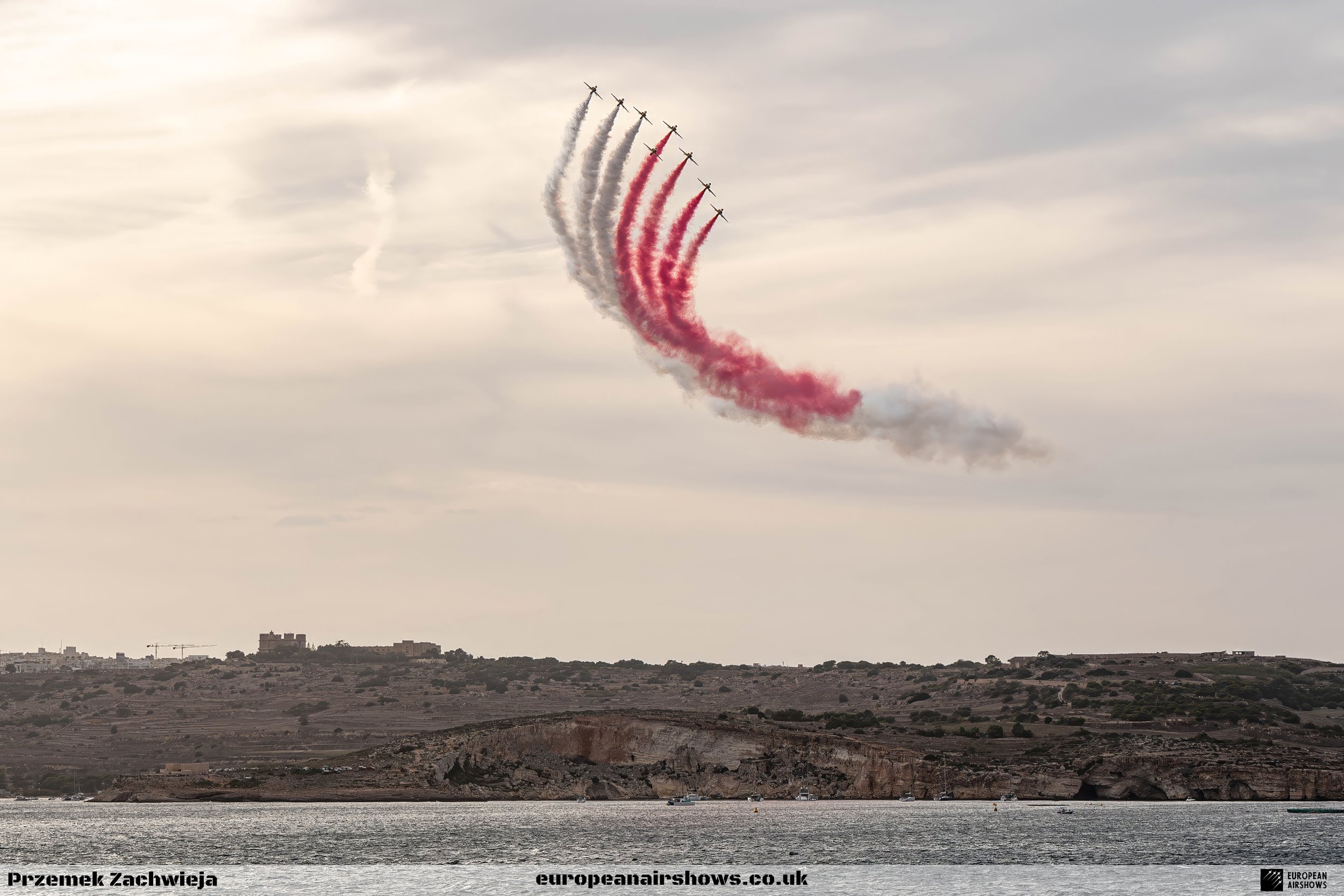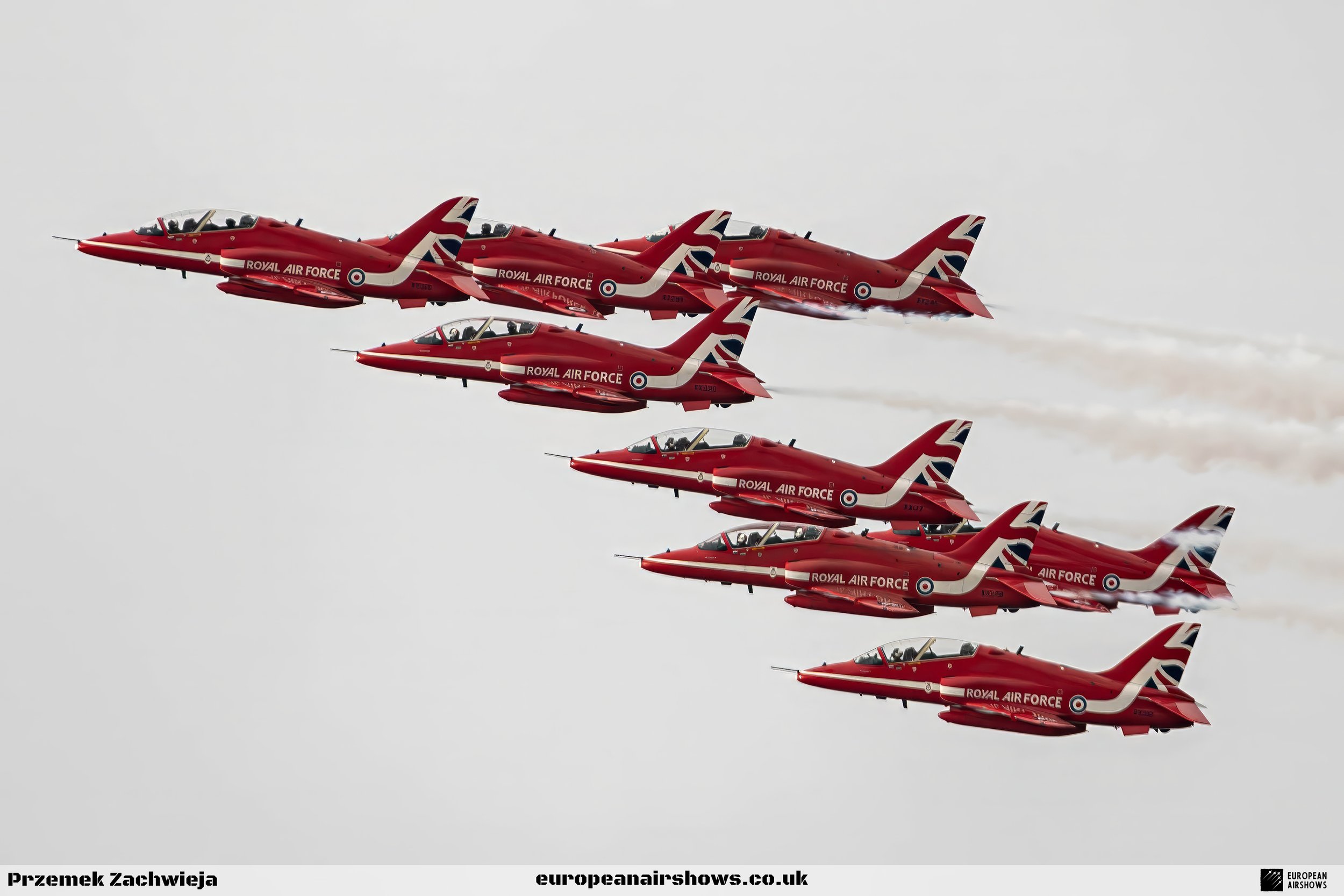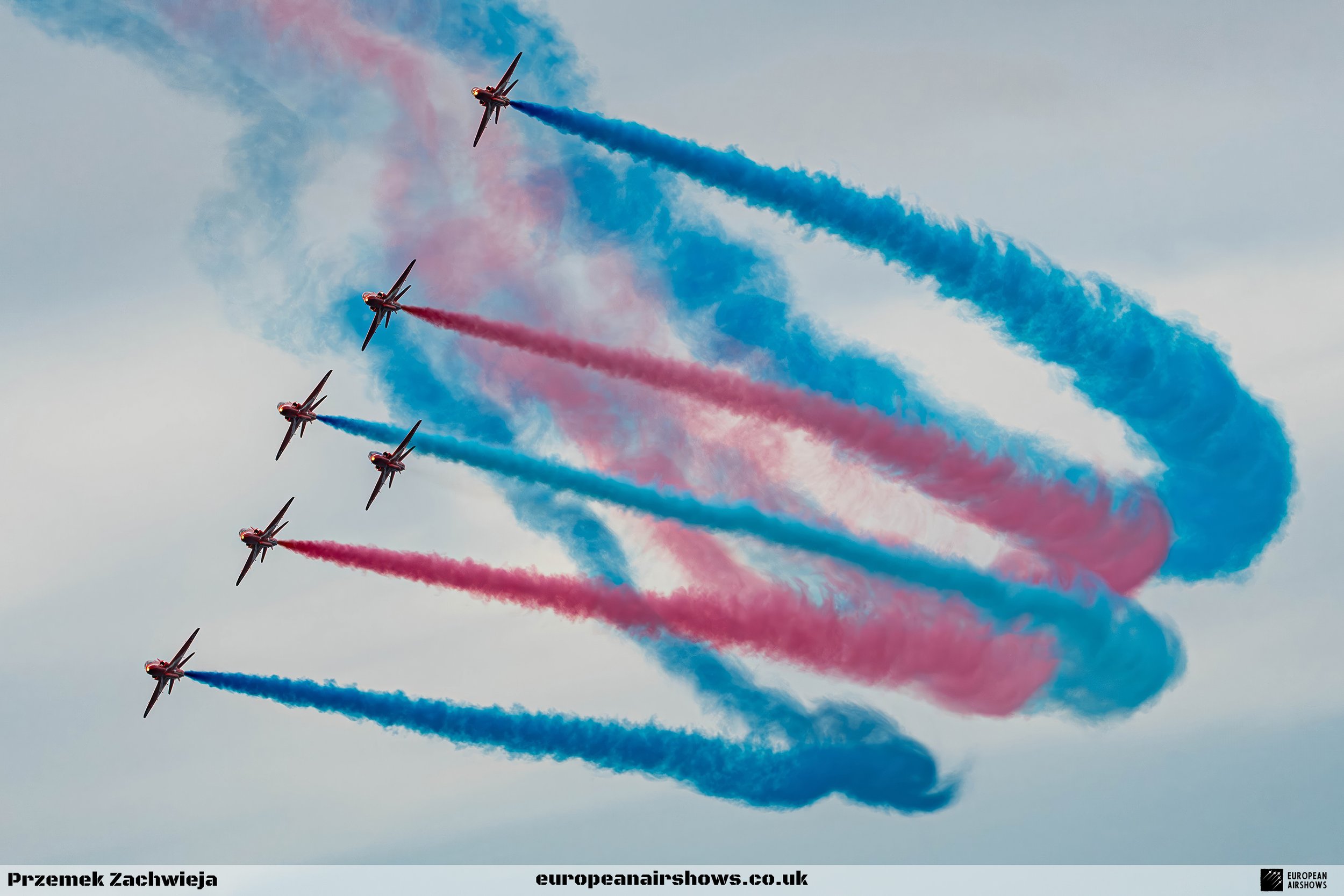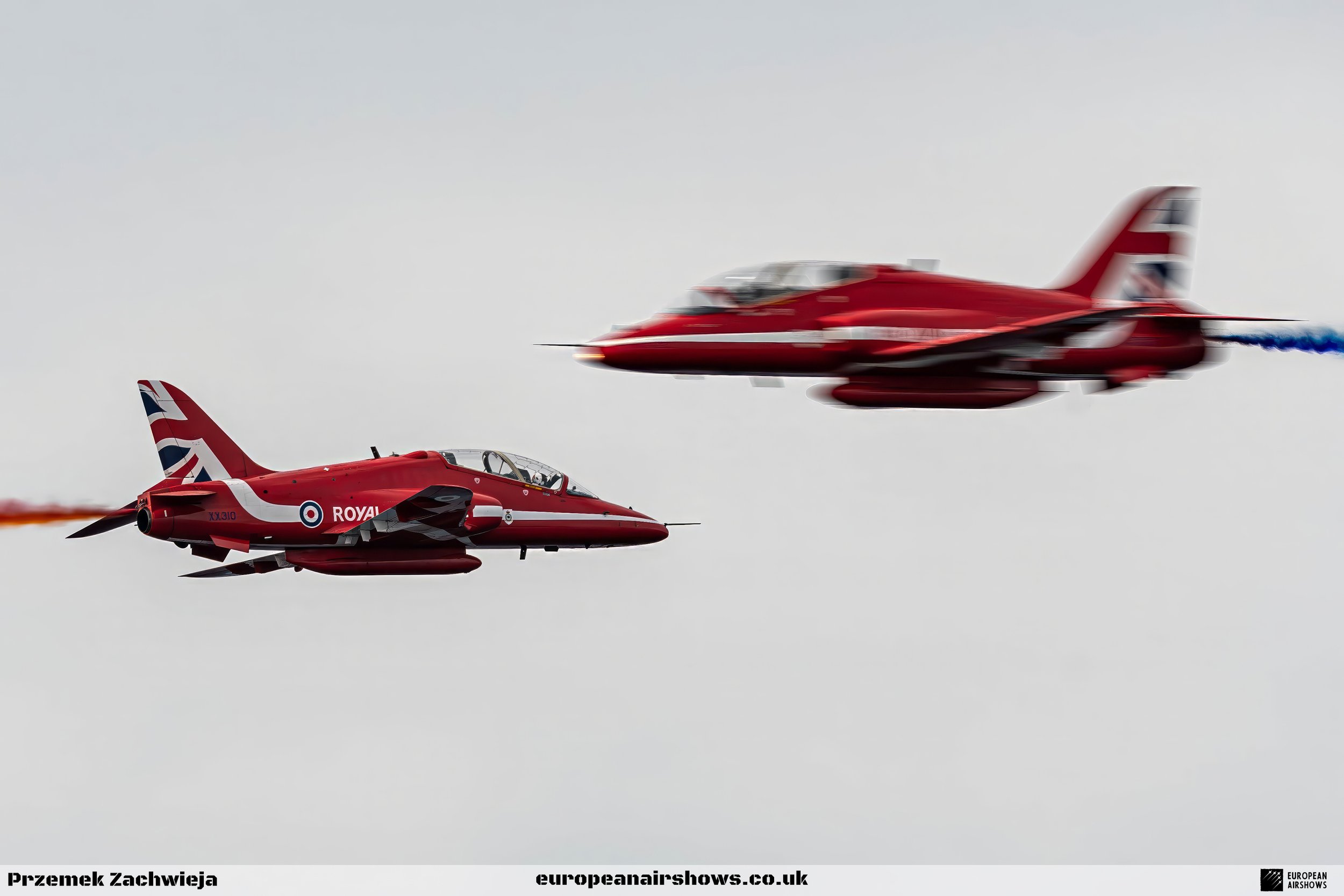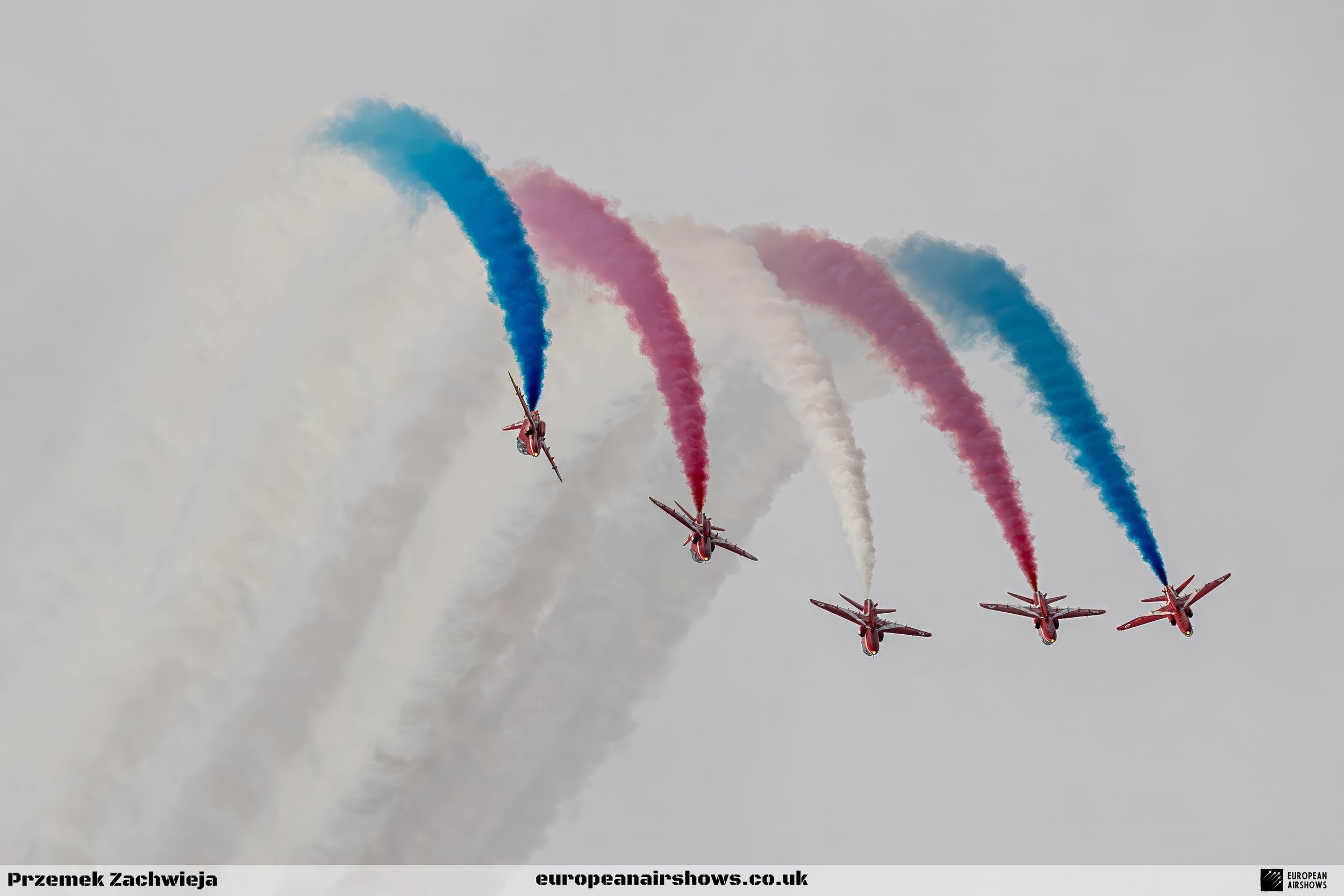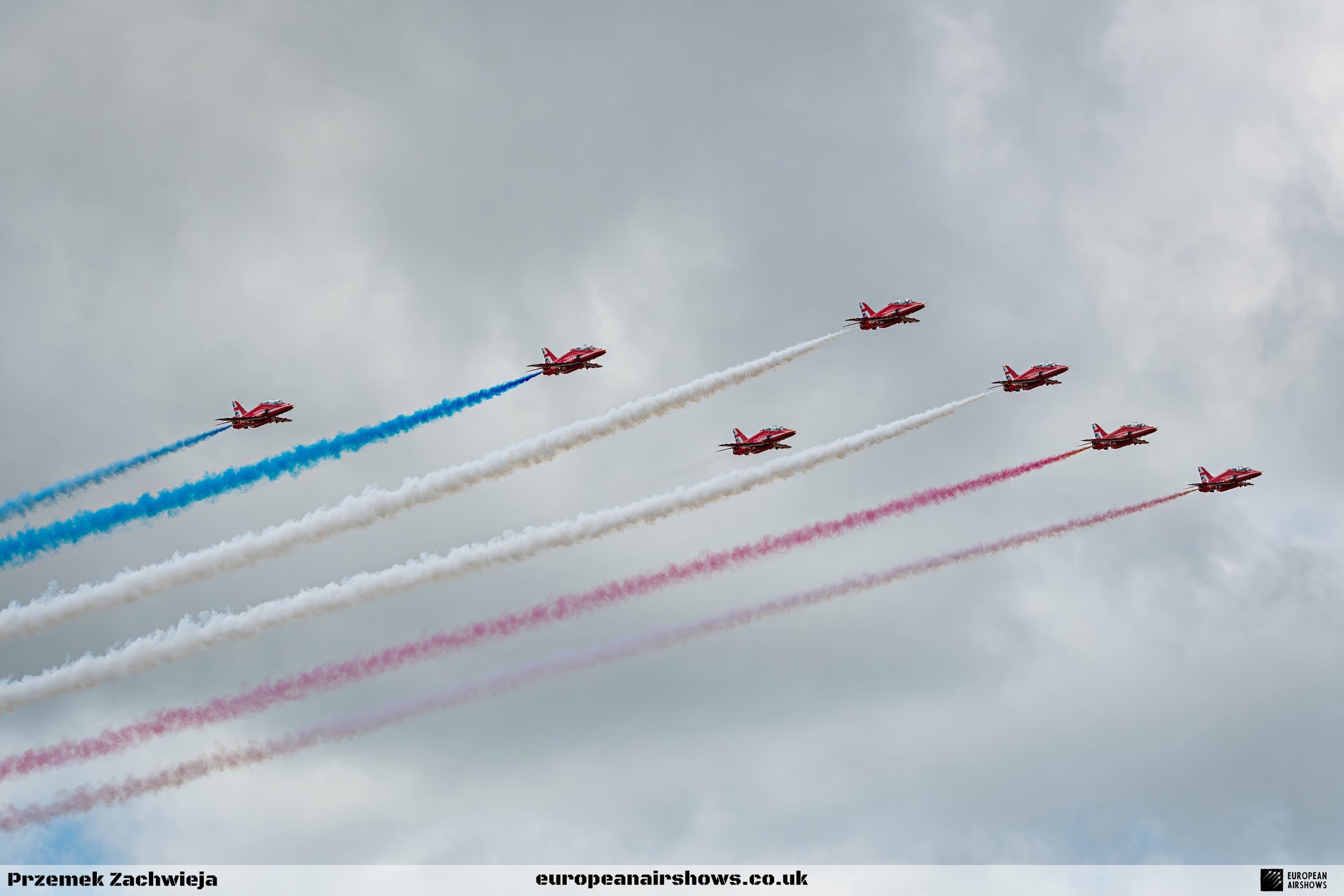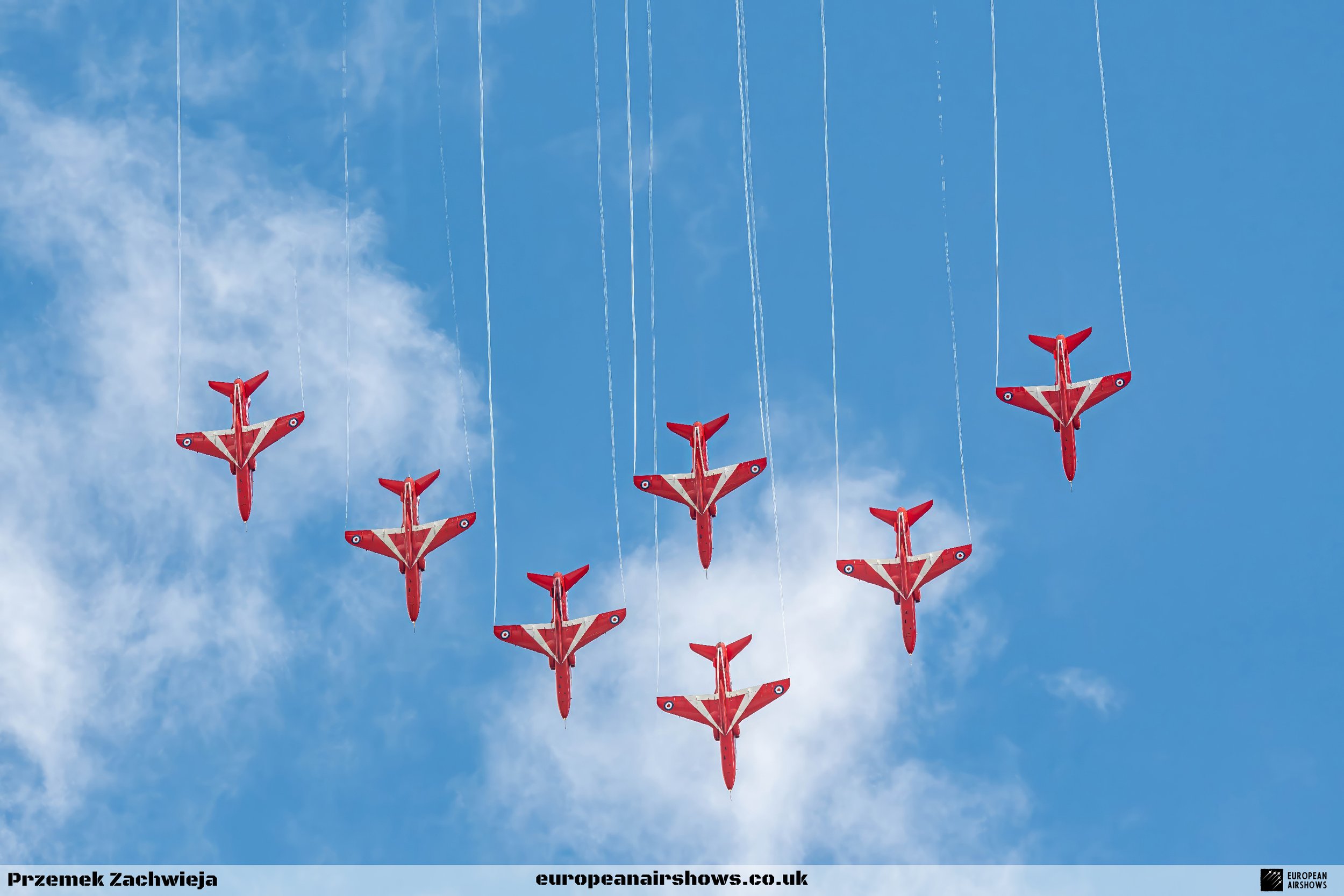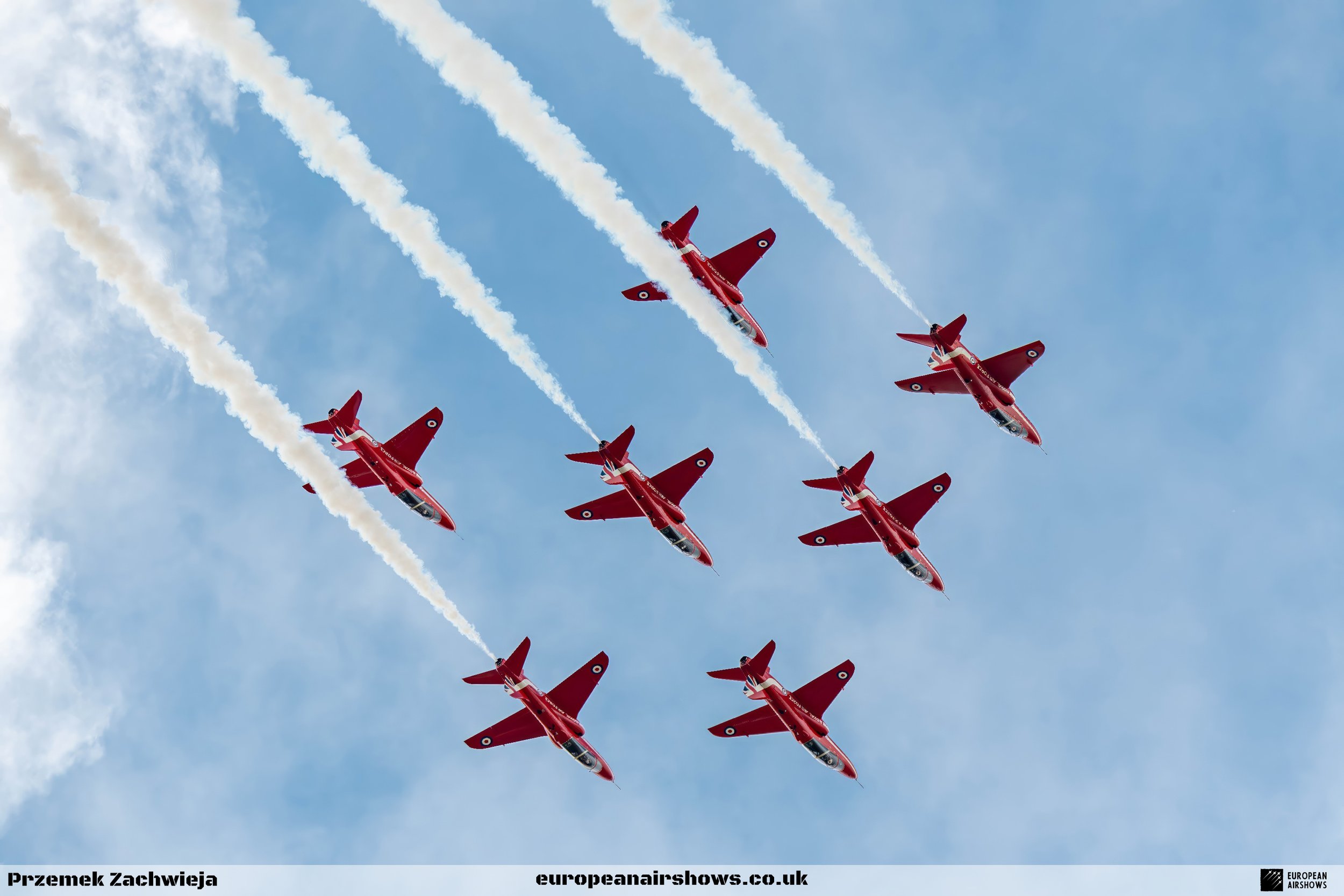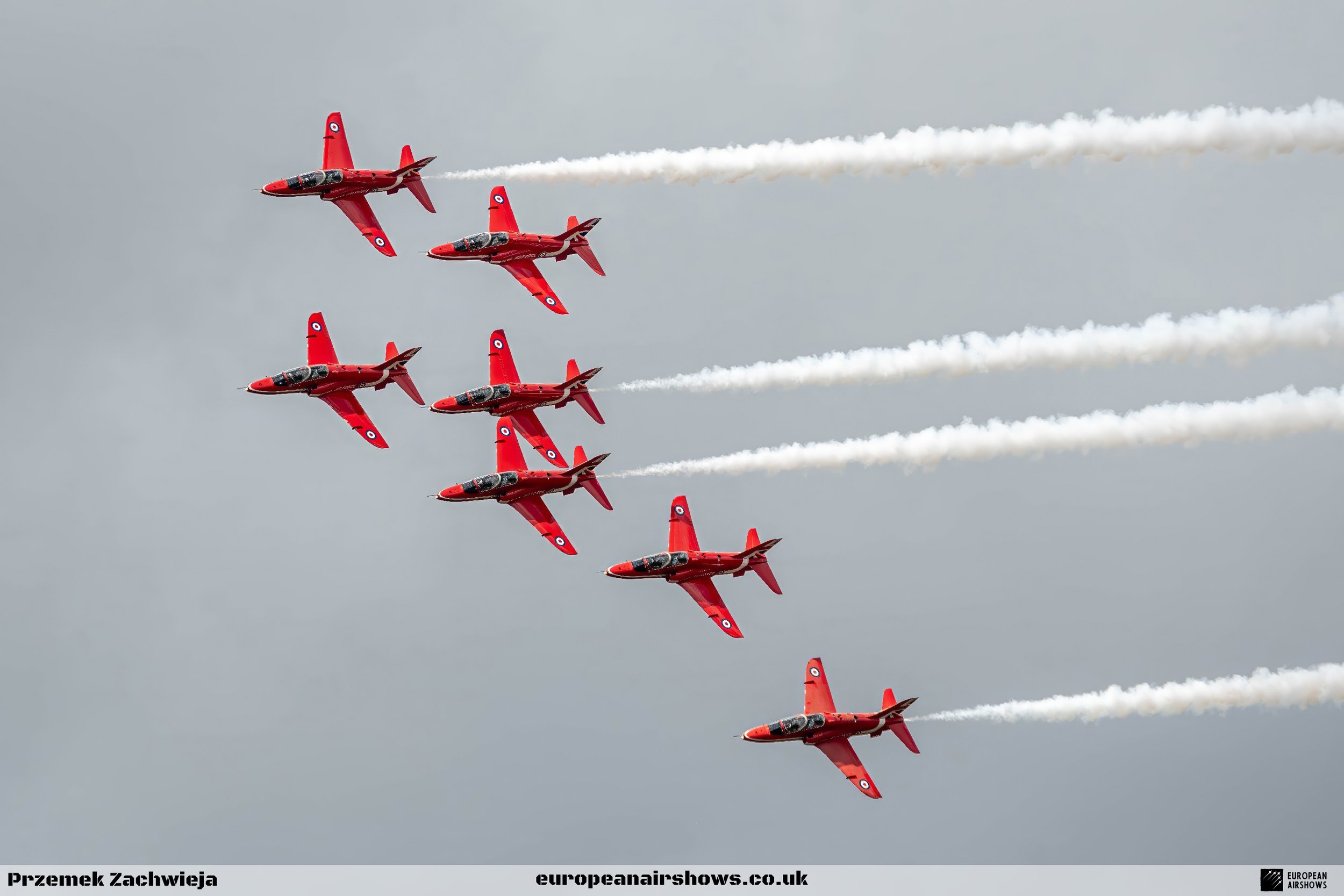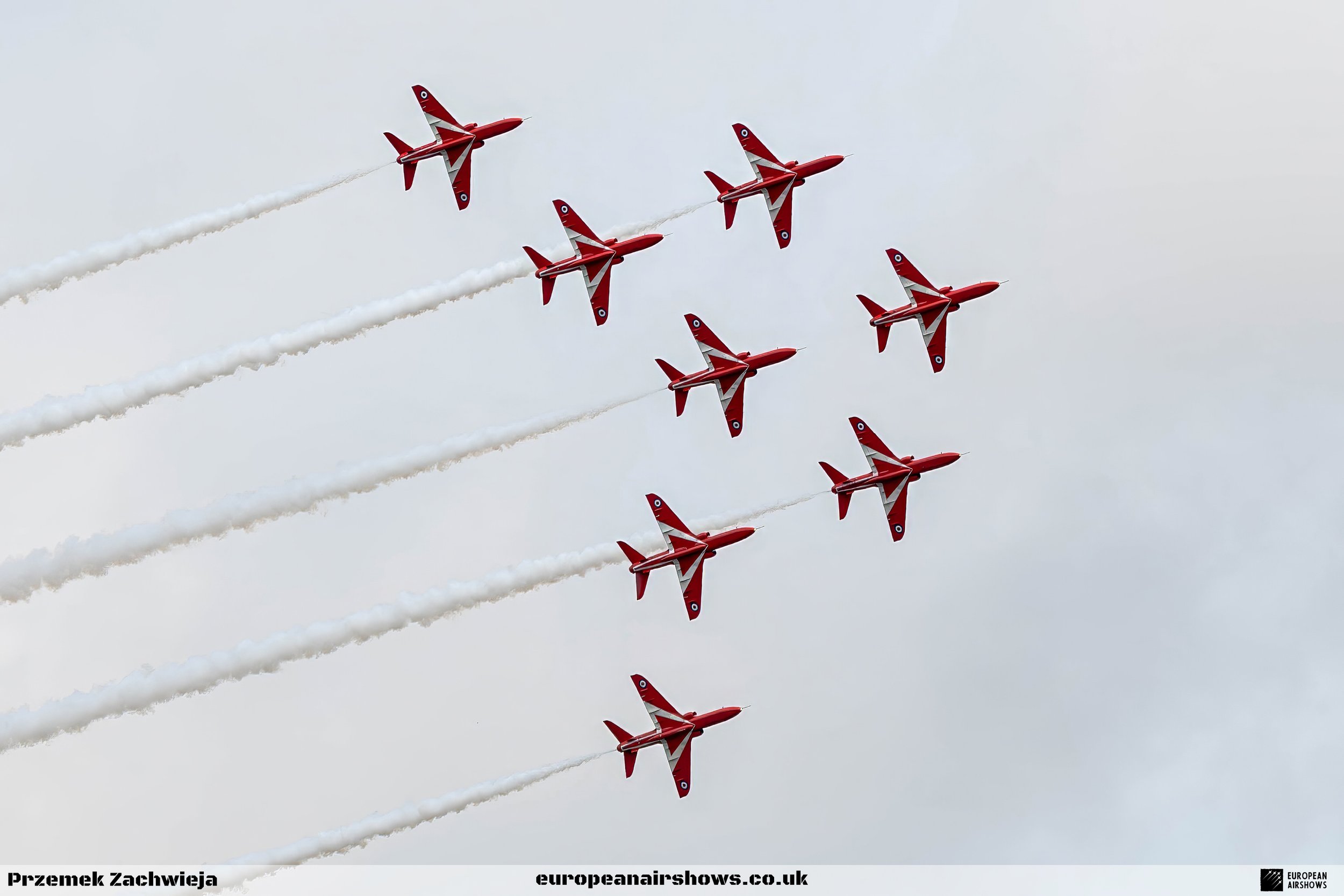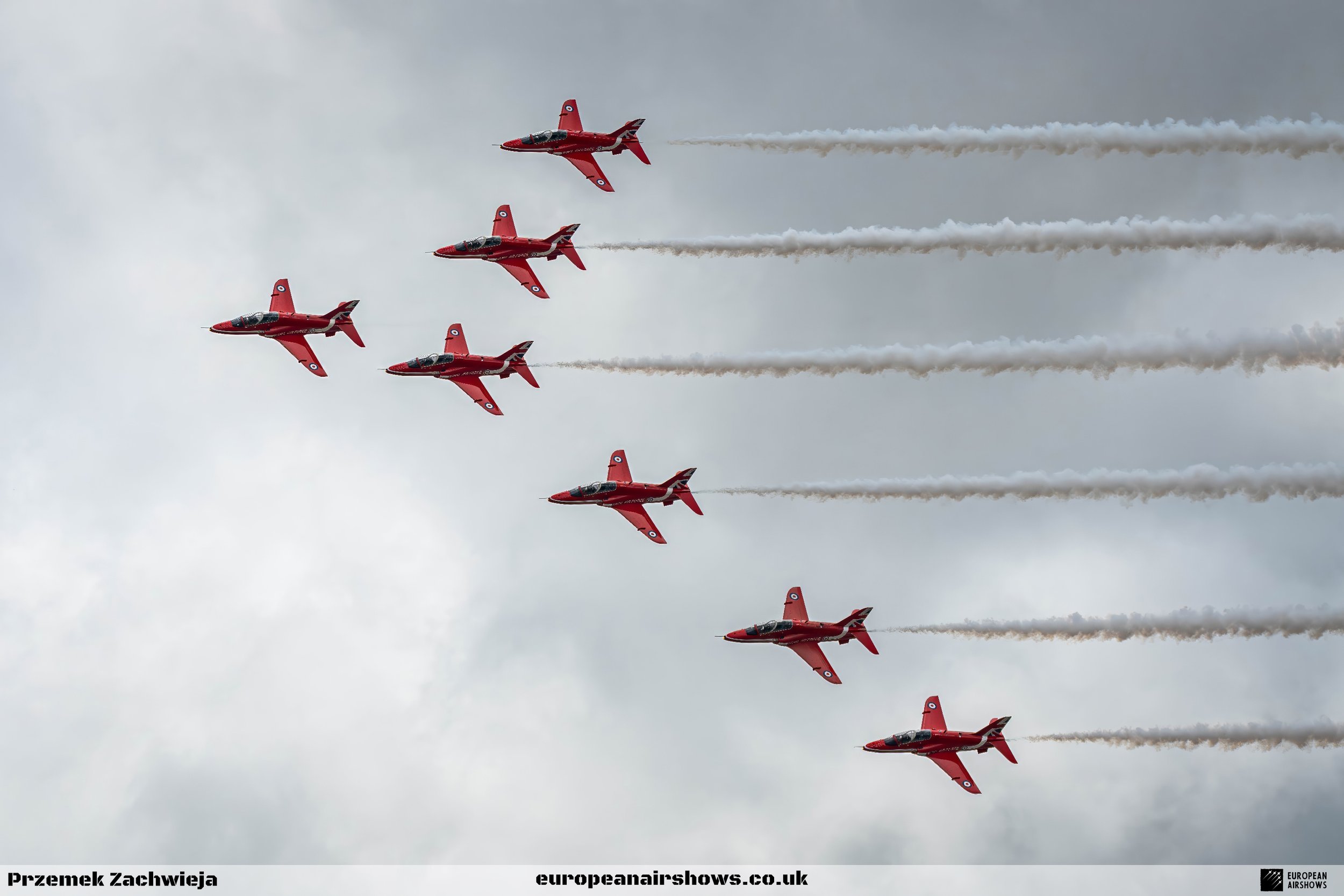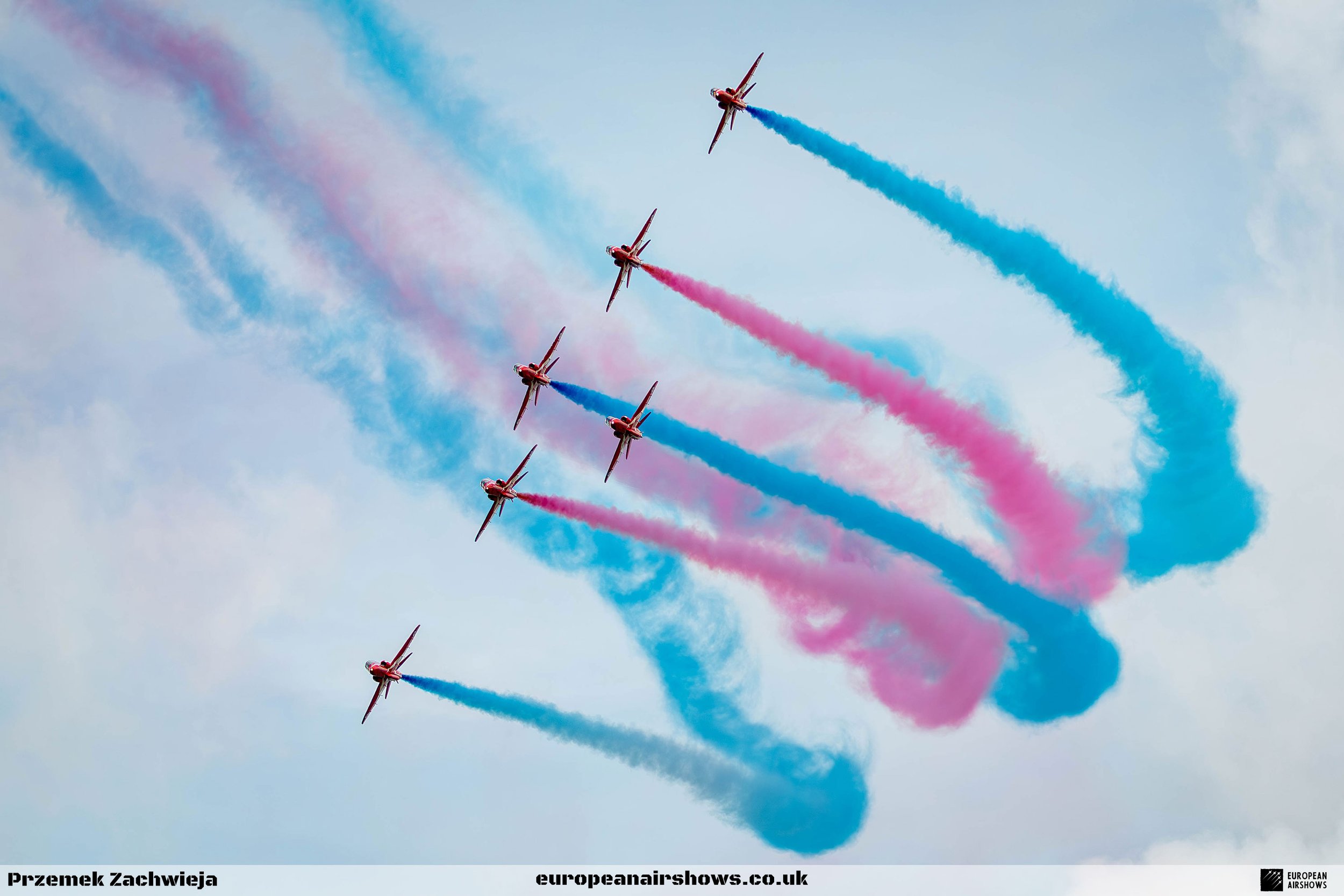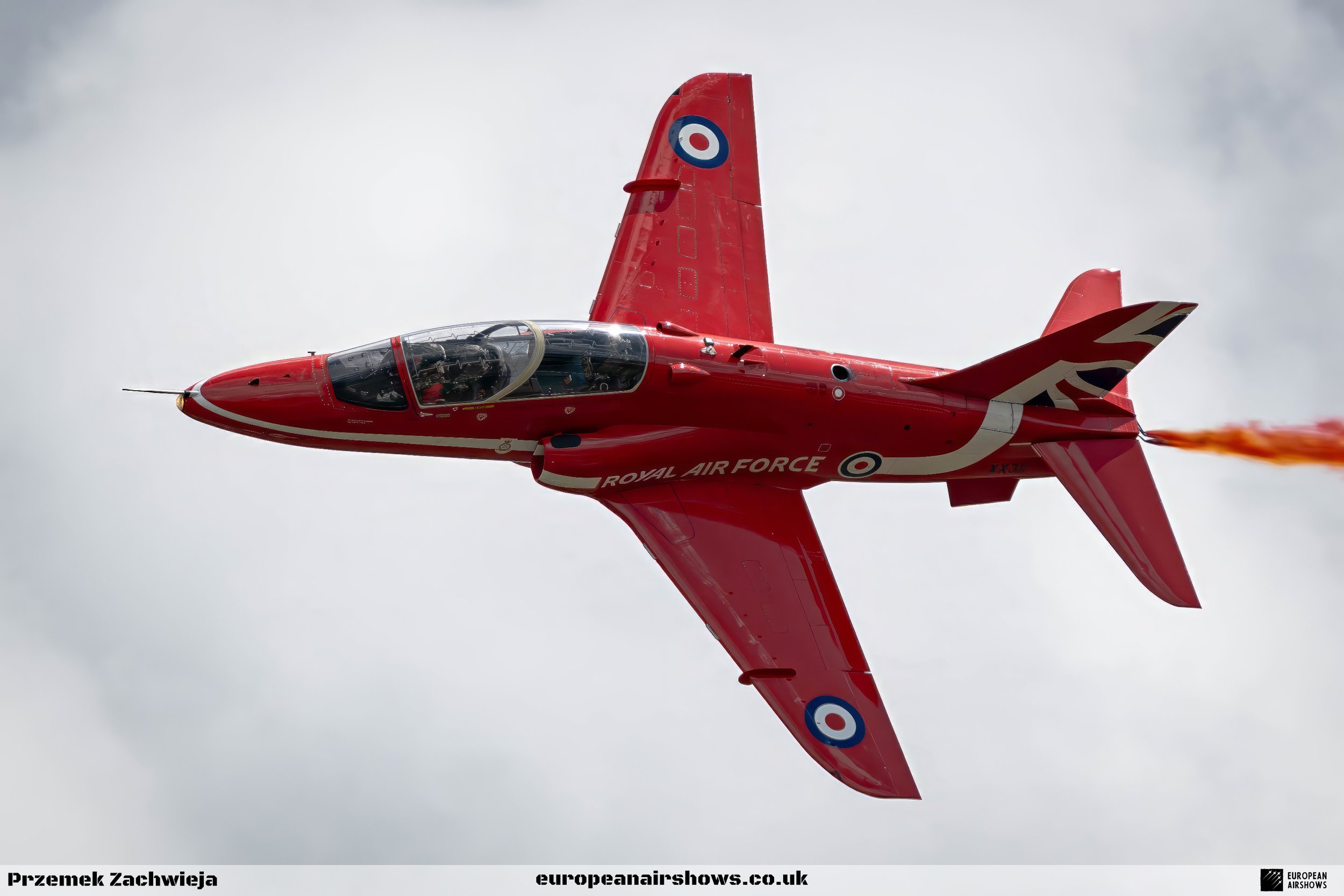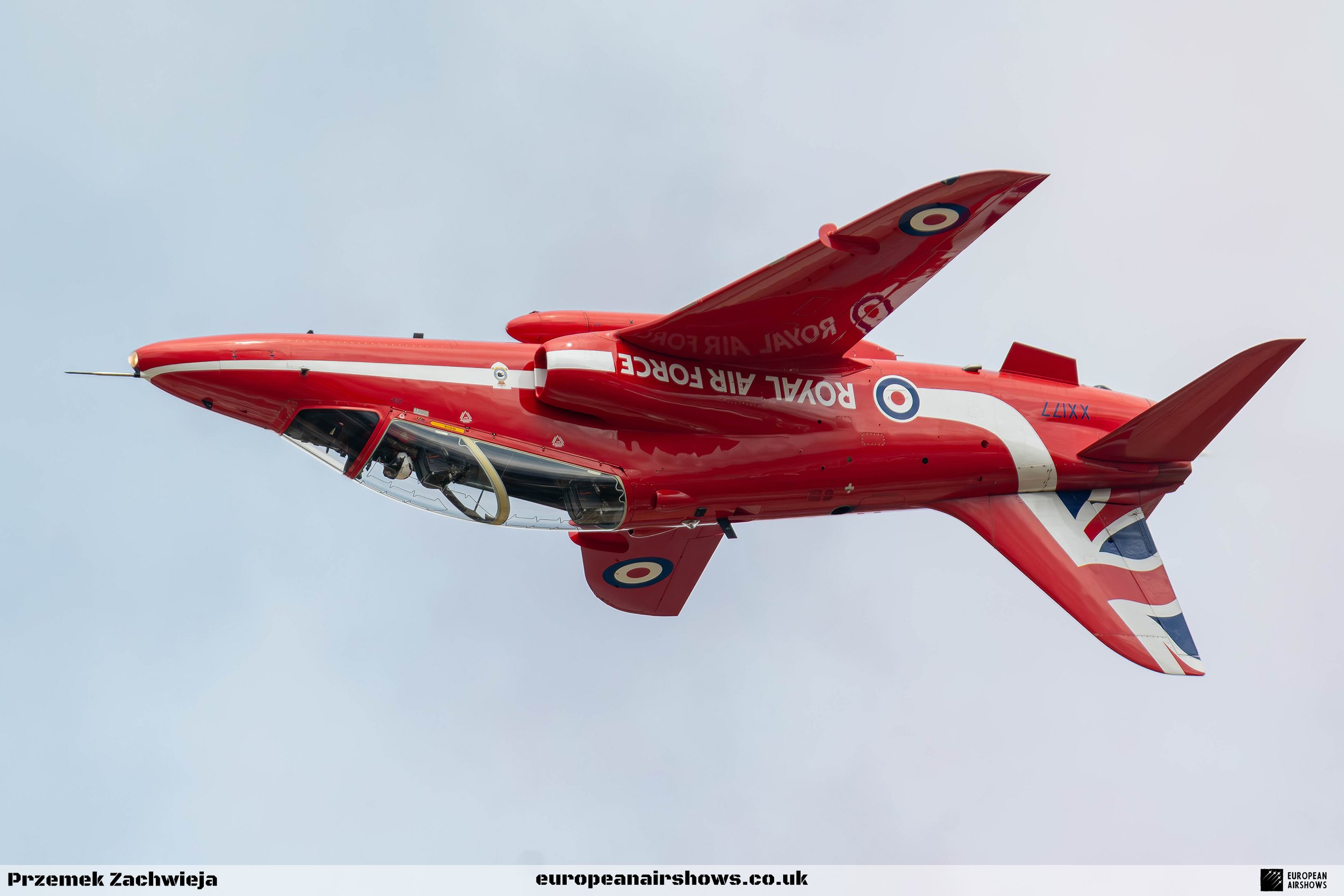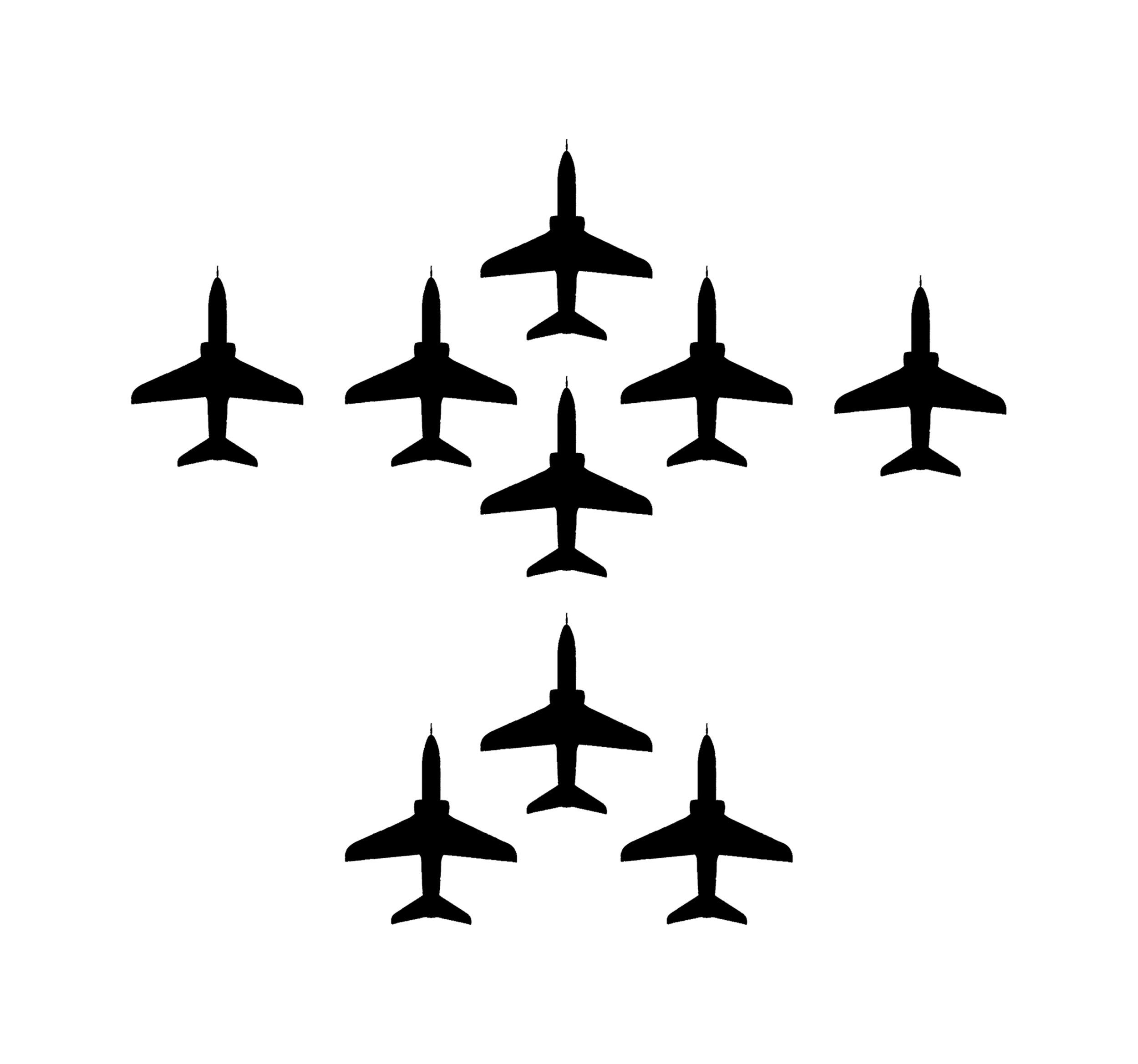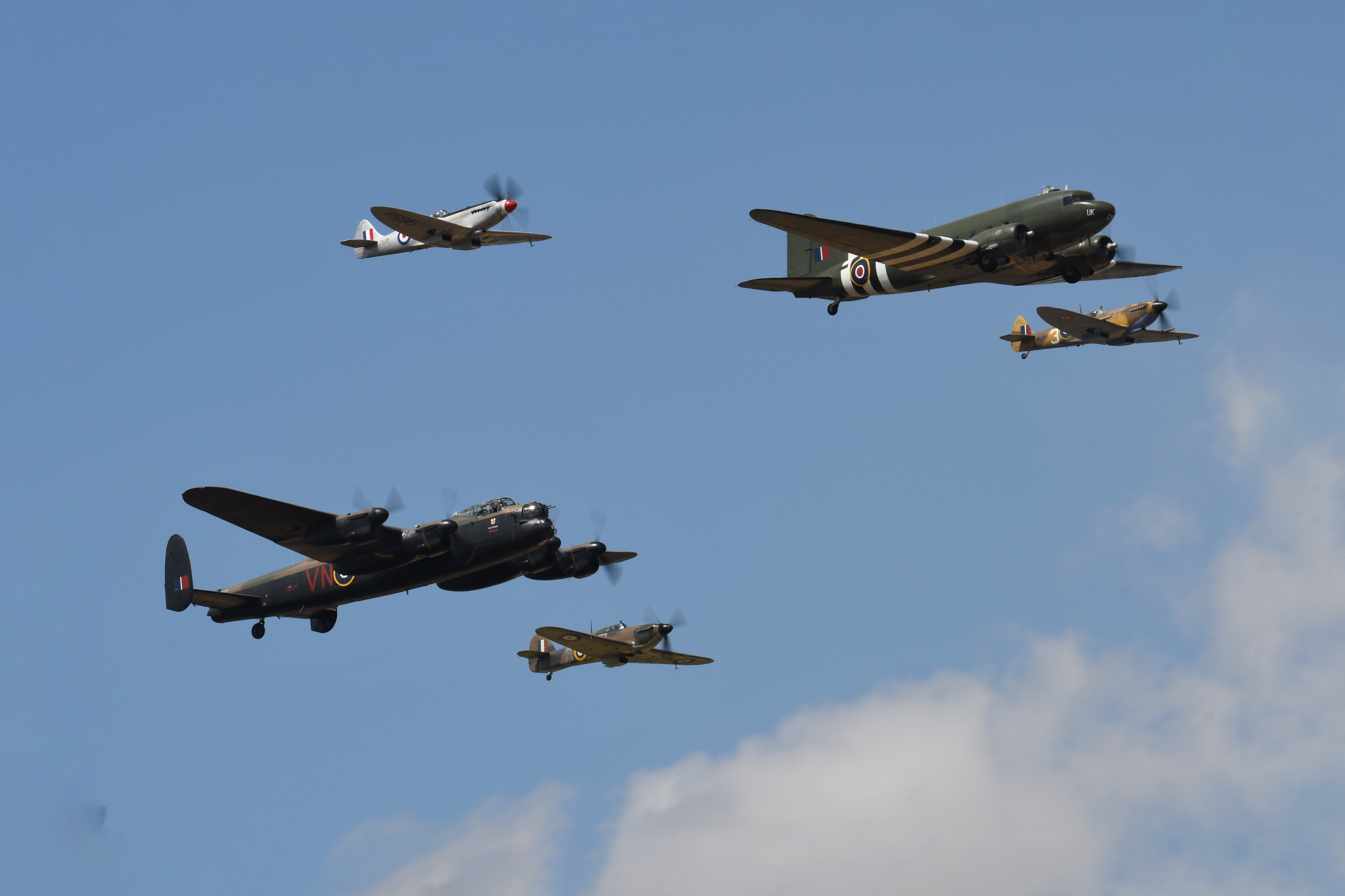Red Arrows
Country
UK
Size
9 Aircraft
Base
RAF Scampton
The Red Arrows, officially known as the Royal Air Force Aerobatic Team, is the aerobatic display team of the Royal Air Force based at RAF Waddington. The team was formed in late 1964 as an all-RAF team, replacing a number of unofficial teams that had been sponsored by RAF commands.
The Red Arrows have a prominent place in British popular culture, with their aerobatic displays at a number of British events. The badge of the Red Arrows shows the aircraft in their trademark diamond nine formation, with the motto Éclat, a French word meaning "brilliance" or "excellence".
Initially, they were equipped with seven Folland Gnat trainers inherited from the RAF Yellowjacks display team. This aircraft was chosen because it was less expensive to operate than front-line fighters. In their first season, they flew at 65 shows across Europe. In 1966, the team was increased to nine members, enabling them to develop their Diamond Nine formation. In late 1979, they switched to the BAE Hawk trainer. Since then The Red Arrows have performed over 4,800 displays in 57 countries worldwide.
History
The Red Arrows were not the first RAF aerobatics team. An RAF pageant was held at Hendon in 1920 with teams from front-line biplane squadrons.
In 1925, No. 32 Squadron RAF flew an air display six nights a week entitled "London Defended" at the British Empire Exhibition. Similar to the display they had done the previous year, when the aircraft were painted black, it consisted of a night-time air display over the Wembley Exhibition flying RAF Sopwith Snipes which were painted red for the display and fitted with white lights on the wings, tail, and fuselage. The display involved firing blank ammunition into the stadium crowds and dropping pyrotechnics from the aeroplanes to simulate shrapnel from guns on the ground. Explosions on the ground also produced the effect of bombs being dropped into the stadium by the aeroplanes. One of the pilots in the display was Flying Officer C. W. A. Scott, who later became famous for breaking three England–Australia solo flight records and winning the MacRobertson Air Race with co-pilot Tom Campbell Black in 1934.
In 1947, the first jet team of three de Havilland Vampires came from RAF Odiham Fighter Wing. Various teams flew the Vampire, and in 1950, No. 72 Squadron was flying a team of seven. No. 54 Squadron became the first RAF jet formation team to use smoke trails. Vampires were replaced by Gloster Meteors, No. 66 Squadron developing a formation team of six aircraft.
Hawker Hunter aircraft were first used for aerobatics teams in 1955, when No. 54 Squadron flew a formation of four.
The official RAF team was provided by No. 111 Squadron in 1956, and for the first time, the aircraft had a special colour scheme, which was an all-black finish. After a demonstration in France, they were hailed as "Les Fleches Noires" and from then on known as the Black Arrows. This team became the first team to fly a five-Hunter formation. In 1958, the Black Arrows performed a loop and barrel roll of 22 Hunters, a world record for the greatest number of aircraft looped in formation. The Black Arrows were the premier team until 1961, when the Blue Diamonds of No. 92 Squadron continued their role, flying 16 blue Hunters.
In 1960, the Tigers of No. 74 Squadron were re-equipped with the supersonic English Electric Lightning and performed wing-overs and rolls with nine aircraft in tight formation. They sometimes gave coordinated displays with the Blue Diamonds. Yet another aerobatics team was formed in 1960 by No. 56 Squadron, the Firebirds, with nine red and silver Lightnings.
In 1964, the Red Pelicans, flying six BAC Jet Provost T Mk 4s, assumed the role of the RAF's leading display team. In that same year, a team of five yellow Gnat trainers from No 4 Flying Training School displayed at the Farnborough Airshow. This team became known as the Yellowjackets after Flight Lieutenant Lee Jones's call sign, "Yellowjack".
In 1964, all the RAF display teams were amalgamated, as it was feared pilots were spending too much time practising formation aerobatics rather than operational training. The new team name took the word "red" from the fact that the Red Pelicans' planes had been painted red (for safety reasons, as it was a far clearer and more visible colour in the sky) and "arrows" after the Black Arrows.
The Royal Air Force Aerobatic Team, the formal name of the Red Arrows, began life at RAF Little Rissington in Gloucestershire, then the Central Flying School. The Red Arrows moved to RAF Kemble, now Cotswold Airport, in 1966 after RAF Fairford became the place of choice for BAC to run test flights for Concorde. When RAF Scampton became the CFS headquarters in 1983, the Red Arrows moved there. As an economic measure, Scampton closed in 1995, so the Red Arrows moved just 20 miles to RAF Cranwell; however, as they still used the air space above Scampton, the emergency facilities and runways had to be maintained. Since the 21st of December 2000, the Red Arrows have been based again at RAF Scampton, near Lincoln.
The first team, led by Squadron Leader Lee Jones, had seven display pilots and flew the Folland Gnat T1 jet trainers. The first display in the UK was on the 6th of May 1965, at Little Rissington for a press day. At the subsequent National Air Day display, three days later, at Clermont Ferrand in France, one French journalist described the team as "Les Fleches Rouges", confirming the name "The Red Arrows". By the end of their first season, the Red Arrows had displayed 65 times in Britain, France, Italy, Holland, Germany, and Belgium and were awarded the Britannia Trophy by the Royal Aero Club for their contribution to aviation.
In 1968, the then team leader Sqn Ldr Ray Hanna expanded the team from seven to nine jets, as he wanted to expand the team's capabilities and the permutations of formation patterns. During this season, the 'Diamond Nine' pattern was formed and it has remained the team's trademark pattern ever since. Ray Hanna served as Red Leader for three consecutive years until 1968 and was recalled to supersede Squadron Leader Timothy Nelson for the 1969 display season, a record four seasons as Leader, which still stands. For his considerable achievements of airmanship with the team, Ray Hanna was awarded a bar to his existing Air Force Cross.
After displaying 1,292 times in the Folland Gnat, the Red Arrows took delivery of the BAE Hawk in 1979. Since being introduced into service with the Red Arrows, the Hawk has performed with the Red Arrows in 50 countries.
In July 2004, speculation surfaced in the British media that the Red Arrows would be disbanded, after a defence spending review, due to running costs between £5 million and £6 million. The Arrows were not disbanded and their expense has been justified through the benefit of their public relations of helping to develop business in the defence industry and promoting recruitment for the RAF. According to the BBC, disbanding the Red Arrows will be highly unlikely, as they are a considerable attraction throughout the world. This was reiterated by Prime Minister David Cameron on the 20th of February 2013, when he guaranteed the estimated £9m per annum costs while visiting India to discuss a possible sale of Hawk aircraft to be used by India's military aerobatics team, the Surya Kiran.
With the planned closure of RAF Scampton, the future home of the Red Arrows became uncertain. On the 20th of May 2008, months of speculation were ended when it was revealed that the Ministry of Defence were moving the Red Arrows to nearby RAF Waddington. However, in December 2011, those plans were put under review. The Ministry of Defence confirmed in June 2012 that the Red Arrows would remain at RAF Scampton until at least the end of the decade. Scampton's runway was resurfaced as a result.
In July 2018 the RAF announced that RAF Scampton would close by 2022, and in May 2020 it was announced that the Red Arrows would be relocated to nearby RAF Waddington. The Red Arrows will continue to use airspace above RAF Scampton for their training.
Since 1966, the team has had nine display pilots each year, all volunteers. Pilots must have completed one or more operational tours on a fast jet such as the Tornado, Harrier, or Typhoon, have accumulated at least 1,500 flying hours, and have been assessed as above average in their operational role to be eligible. Even then, more than ten pilots apply for each place on the team. Pilots stay with the Red Arrows for a three-year tour of duty. Three pilots are changed every year, such that normally three first-year pilots, three second-year pilots, and three in their final year are on the team. The team leader also spends three years with the team. The 'Boss', as he is known to the rest of the team, is always a pilot who has previously completed a three-year tour with the Red Arrows, often (although not always) including a season as the leader of the Synchro Pair.
During the second half of each display, the Red Arrows split into two sections. Reds 1 to 5 are known as 'Enid' (named after Enid Blyton, author of the Famous Five books) and Reds 6 to 9 are known as 'Gypo' (the nickname of one of the team's pilots back in the 1960s). Enid continues to perform close-formation aerobatics, while Gypo performs more dynamic manoeuvres. Red 6 (Syncro Leader) and Red 7 (Synchro 2) make up the Synchro Pair and they perform a series of opposition passes during this second half. At the end of each season, one of that year's new pilots will be chosen to be Red 7 for the following season, with that year's Red 7 taking over as Red 6.
The Reds have no reserve pilots, as spare pilots would not perform often enough to fly to the standard required, nor would they be able to learn the intricacies of each position in the formation. If one of the pilots is not able to fly, the team flies an eight-plane formation. However, if the Team Leader, 'Red 1', is unable to fly, then the team does not display at all. Each pilot always flies the same position in the formation during a season. The pilots spend six months from October to April practising for the display season. Pilots wear green flying suits during training and are only allowed to wear their red flying suits once they are awarded their Public Display Authority at the end of winter training.
The new pilots joining the team spend their first season flying at the front of the formation near the team leader. As their experience and proficiency improve, they move to positions further back in the formation in their second and third seasons. Pilots who start on the left of the formation stay on that side for the duration of their three-year tour; the pilots on the right side stay on the right. The exception to this is Reds 6 and 7 (the Synchro Pair), who fly in the 'stem' of the formation - the two positions behind the team leader.
During an aerobatics display, Red Arrows pilots experience forces up to five times that of gravity, and when performing the aerobatic manoeuvre 'Vixen Break', forces up to 7g can be reached, close to the 8g structural limit of the aircraft.
As well as the nine pilots, 'Red 10', who is the team supervisor, is a fully qualified Hawk pilot who flies the tenth aircraft when the Red Arrows are away from the base. This means the team have a reserve aircraft at the display site. Red 10's duties include co-ordination of all practices and displays and acting as the team's ground safety officer. Red 10 often flies TV cameramen and photographers for air-to-air pictures of the Red Arrows and also provides commentary for all of the team's displays.
On the 13th pg May 2009, it was announced that the Red Arrows would include their first female display pilot. Flt Lt Kirsty Moore joined for the 2010 season. Flt Lt Moore was not the first female to apply to become a Red Arrow but was the first to be taken forward to the intense final selection process. She joined the RAF in 1998 and was a qualified flying instructor on the Hawk aircraft at RAF Valley. Prior to joining the team, she flew the Tornado GR4 at RAF Marham.
The engineering team that supports the Red Arrows is known as "The Blues" and consists of 85 members drawn from various technical (and support) trades in the RAF. Each season nine members of the Blues are selected to be members of the 'Circus'. The position of "Circus 1" (the engineer who accompanies the "Boss", Red 1) is normally occupied by the Junior Engineering Officer. Similarly, the position of Circus leader (Red 6 or 7) is occupied by a technician of sergeant rank; the other slots being filled by technicians holding corporal or senior aircraftsman/woman (SAC(W)) rank. Each member of the Circus works with the same pilot for the duration of the season and is responsible for servicing their aircraft and preparing their flying kit prior to each display. Circus members fly in the back seats of the jets during transit flights.
The team use the same two-seat training aircraft used for advanced pilot training, at first the Folland Gnat which was replaced in 1979 by the BAE Hawk T1. The Hawks are modified with an uprated engine and a modification to enable smoke to be generated; diesel is mixed with a coloured dye and ejected into the jet exhaust to produce either red, white or blue smoke.
The first display by the Red Arrows was at RAF Little Rissington on 6 May 1965. The display was to introduce the Royal Air Force Aerobatic Team to the media. However, the first public display was on the 9th of May 1965 in France, at the French National Air Day in Clermont-Ferrand. The first public display in the UK was on the 15th of May 1965 at the Biggin Hill International Air Fair. The first display with nine aircraft was on the 8th of July 1966 at RAF Little Rissington.
During displays, the aircraft does not fly directly over the crowd apart from entering the display area by flying over the crowd from behind; any manoeuvres in front of and parallel to the audience can be as low as 300 feet, the 'synchro pair' can go as low as 100-foot straight and level, or 150-foot when in inverted flight. To carry out a full looping display the cloud base must be above 5,500 feet to avoid the team entering the cloud while looping. If the cloud base is less than 5,500-foot but more than 2,500-foot the Team will perform the Rolling Display, substituting wing-overs and rolls for the loops. If the cloud base is less than 2,500-foot the Team will fly the Flat Display, which consists of a series of fly-pasts and steep turns.
The greatest number of displays flown in any year was in 1995 when the Red Arrows performed 136 times. The smallest number of displays in one year was in 1975 after the 1973 oil crisis limited their appearances. At a charity auction in 2008, a British woman paid £1.5 million to fly with them.
By the end of the 2009 season, the Red Arrows had performed a total of 4,269 displays in 53 countries. The 4,000th display was at RAF Leuchars during the Battle of Britain Airshow in September 2006.
Following the accidents during the 2011 season, the Red Arrows retained Red 8 and moved the original Red 10 to the Red 5 position to enable them to continue displaying with nine aircraft. In March 2012, the MOD announced that the Red Arrows would fly aerobatic displays with seven aircraft during the 2012 display season as Flt Lt Kirsty Stewart had moved into a ground-based role with the team. It is believed this was due to the emotional stress she had been suffering over the loss of her two Red Arrows colleagues the previous year. As a consequence of this, Red 8 also dropped out of the display team to enable an odd number of aircraft to perform and thus maintain formation symmetry. However, the team carried out official flypasts with nine aircraft by utilising Red 8 as well as ex-Red Arrow display pilot and current Red 10 Mike Ling. The Red Arrows returned to a full aerobatic formation of nine aircraft in 2013.
In 2014, The Red Arrows celebrated 50 years of Aerobatic history as a display team returning to RAF Fairford for the Royal International Air Tattoo. For the entirety of the 2014 display season, the aircraft carried special 50th Anniversary markings on their tails instead of just the red, white and blue stripes.
After the 2016 display season, the Red Arrows embarked on an Asia-Pacific and the Middle East Tour. They performed flypasts or displays in Karachi in Pakistan; Hindon and Hyderabad in India; Dhaka in Bangladesh; Singapore; Kuala Lumpur in Malaysia; Danang in Vietnam; Beijing, Shanghai, Wuhan, Guangzhou, Hong Kong and Zhuhai in China; Muscat in Oman; Manama in Bahrain; Abu Dhabi and Kuwait. The programme was the first time the team had displayed in China, and the first time a British military aircraft had deployed to Vietnam.
The summer 2019 display season took the team on a tour of North America, known as Western Hawk 19. After performing at the Royal International Air Tattoo (RIAT), the team departed across the Atlantic at the end of July. As well as performing at US and Canadian air shows, they promoted the UK through school visits and meetings with business leaders. This was the Red Arrows' biggest-ever tour, flying to more than 25 cities, 21 displays and 30 flypasts.
On a transit flight (getting to or from a display location) the team may fly at the relatively low altitude of 1,000 feet (300 m). This avoids the complication of moving through the cloud base in formation, and also avoids much controlled air space. Jets are more efficient at higher altitudes, so longer flights are made at 35,000 to 42,000 feet. On transit flights, the formation can include spare planes. Sometimes a C-130 Hercules or A400M accompanies them, carrying spare parts. They often provide flypasts and brief displays to smaller events if they are already passing over or it is a small detour.
As the fuel capacity of the Hawk sets a limit to nonstop flight distance, and the Hawk is incapable of air-to-air refuelling, very long flights between display sites may need landings on the way to refuel. For example, a flight from RAF Scampton to Quebec for an international air display team competition had to be done in seven hops: RAF Scampton, RAF Kinloss (Scotland), Keflavík (Iceland), Kangerlussuaq (West Greenland), Narsarsuaq (south tip of Greenland), Goose Bay (Newfoundland), Bagotville, Quebec.
For the same reason, Red Arrows displays in New Zealand are unlikely because there is no land near enough for a Hawk to land and refuel to reach New Zealand on the most fuel that it can carry.
The smoke trails left by the team are made by releasing diesel into the exhaust; this vaporizes in the hot exhaust flow, then re-condenses into very fine droplets that give the appearance of a white smoke trail. Dyes can be added to produce red and blue colours. The diesel is stored in the pod on the underside of the plane; it houses three tanks: one 230l tank of pure diesel and two 45l tanks of blue and red dyed diesel. The smoke system uses 45l per minute; therefore each plane can trail smoke for a total of seven minutes: – five minutes of white smoke, a minute of blue and a minute of red.
| Back to Top |
Signature Formations
Short Diamond
Spitfire
Typhoon
| Back to Top |
BAE Systems Hawk T.1
The BAE Systems Hawk is a British single-engine, jet-powered advanced trainer aircraft. It was first flown at Dunsfold, Surrey, in 1974 as the Hawker Siddeley Hawk, and subsequently produced by its successor companies, British Aerospace and BAE Systems. It has been used in a training capacity and as a low-cost combat aircraft.
Operators of the Hawk include the Royal Air Force (notably the Red Arrows display team) and a considerable number of foreign military operators. The Hawk is still in production in the UK and under licence in India by Hindustan Aeronautics Limited, with over 900 Hawks sold to 18 operators around the world.
The Hawk is an advanced trainer with a two-man tandem cockpit, a low-mounted cantilever wing and is powered by a single turbofan engine. Unlike many of the previous trainers in RAF service, the Hawk was specifically designed for training. Hawker had developed the aircraft to have a high level of serviceability, as well as lower purchasing and operating costs than previous trainers like the Jet Provost. The Hawk has been praised by pilots for its agility, in particular, its roll and turn handling.
The design of the fuselage included a height differential between the two seats of the cockpit; this provided generous levels of visibility for the instructor in the rear seat. Each cockpit is fitted with a Martin-Baker Mk 10B zero-zero rocket-assisted ejection seat. Air is fed to the aircraft's rear-mounted Rolls-Royce Turbomeca Adour engine via intakes on each of the forward wing roots. During the aircraft's development, Hawker had worked closely with Rolls-Royce to reduce the engine's fuel consumption and to ensure a high level of reliability.
Even within the development stages, a Hawk variant was intended to also serve as a single-seat ground-attack fighter; both the trainer and fighter models were developed with the export market in mind. On single-seat models, the forward cockpit area which normally houses a pilot is replaced by an electronics bay for avionics and onboard systems, including a fire control computer, multi-mode radar, laser rangefinder and forward-looking infrared. Some export customers, such as Malaysia, have extensive modifications to their aircraft, including the addition of wingtip hardpoint stations and a fittable inflight refuelling probe.
The Hawk was designed to be manoeuvrable and can reach Mach 0.88 in level flight and Mach 1.15 in a dive, thus allowing trainees to experience transonic flight before advancing to a supersonic trainer. The airframe is very durable and strong, stressed for +9 g; the normal limit in RAF service is +7.5/-4 g. A dual hydraulic system supplies power to operate systems such as the aircraft's flaps, airbrakes and landing gear, together with the flight controls. A ram air turbine is fitted in front of the single tail fin to provide backup hydraulic power for the flight controls in the event of an engine failure; additionally, a gas turbine auxiliary power unit is housed directly above the engine.
The Hawk is designed to carry a centreline gun pod, such as the 30 mm ADEN cannon, two under-wing pylons, and up to four hardpoints for fitting armaments and equipment. In RAF service, Hawks have been equipped to operate the Sidewinder air-to-air missiles. In the early 1990s, British Aerospace investigated the possibility of arming the Hawk with the Sea Eagle anti-ship missile for export customers. In 2016, BAE Systems was developing the so-called 'Advanced Hawk' with a new wing using leading-edge slats, and potentially additional sensors and weapons, a head-mounted display, and a single large-screen display in the forward cockpit.
| Back to Top |
